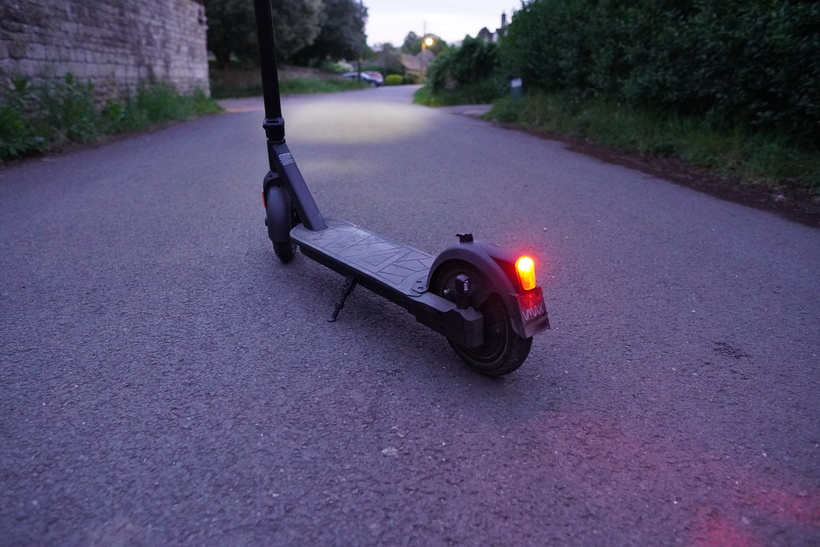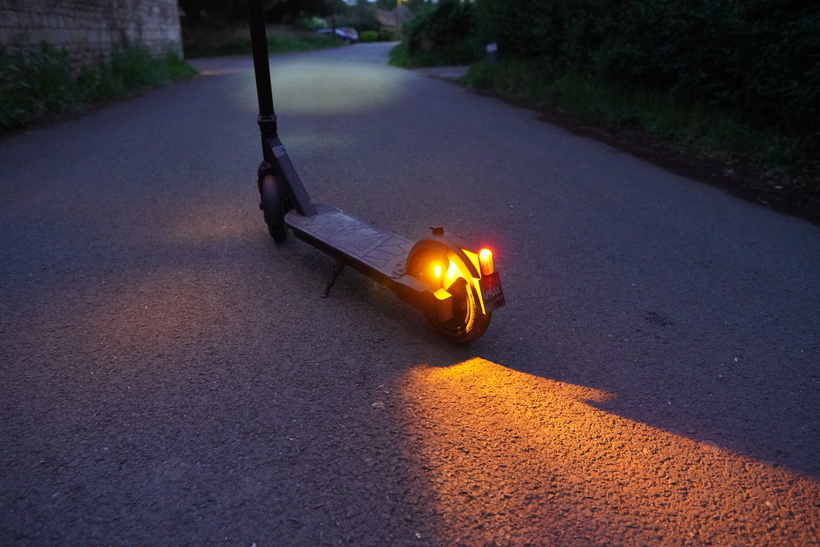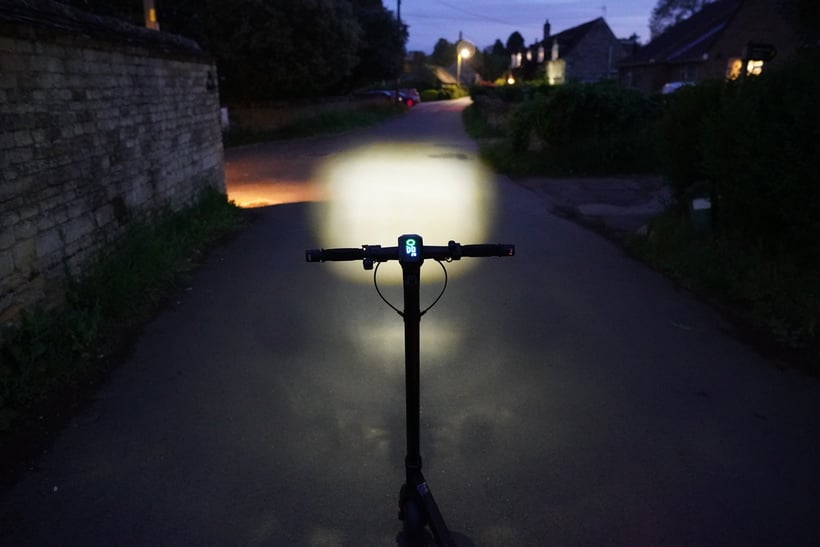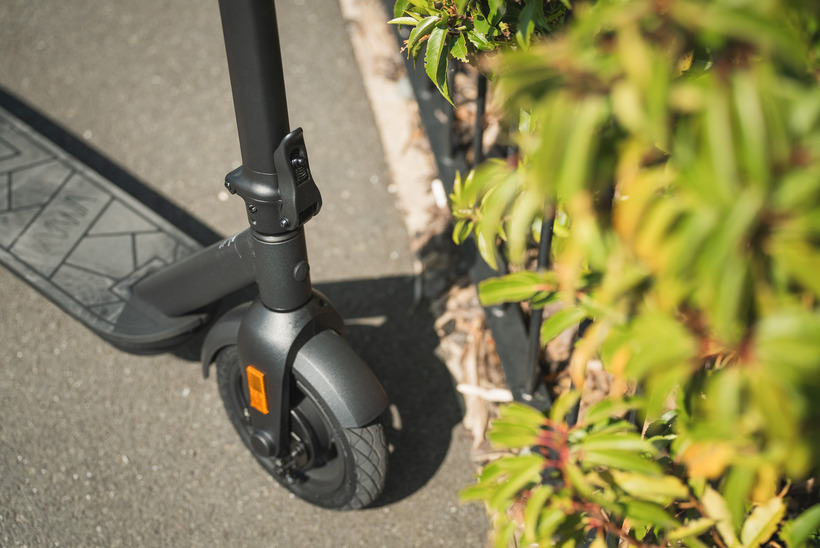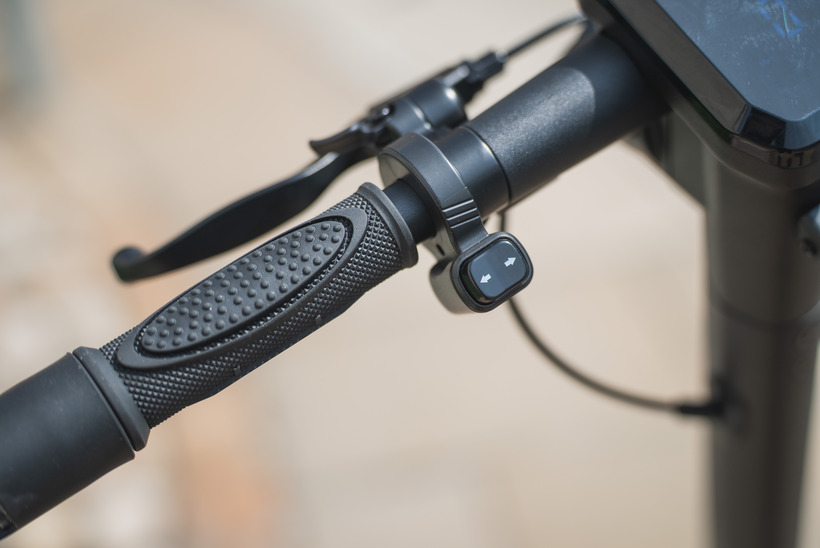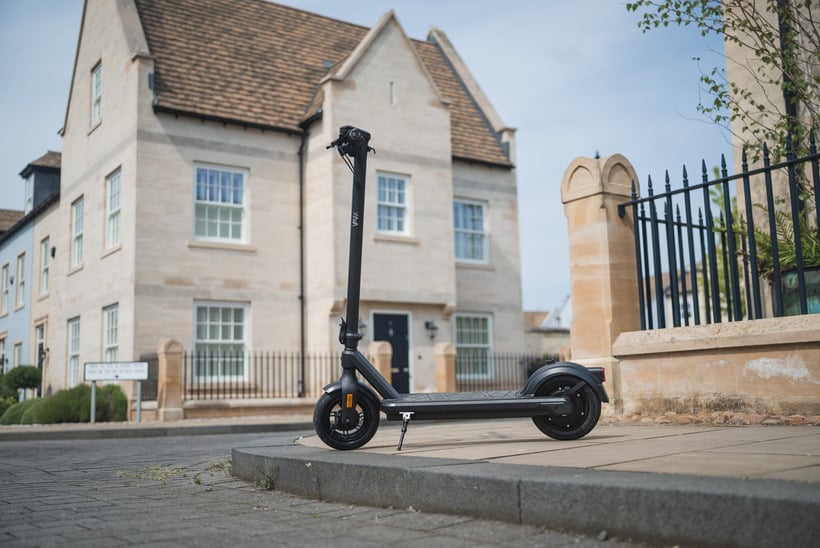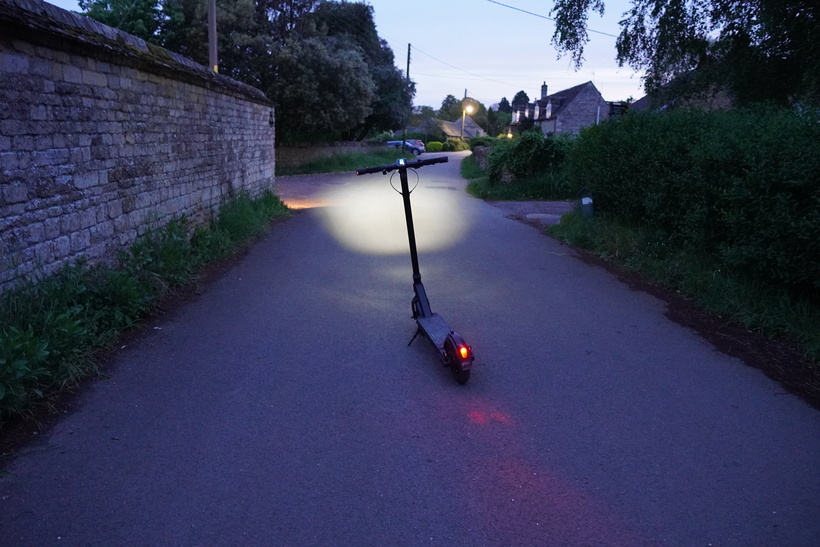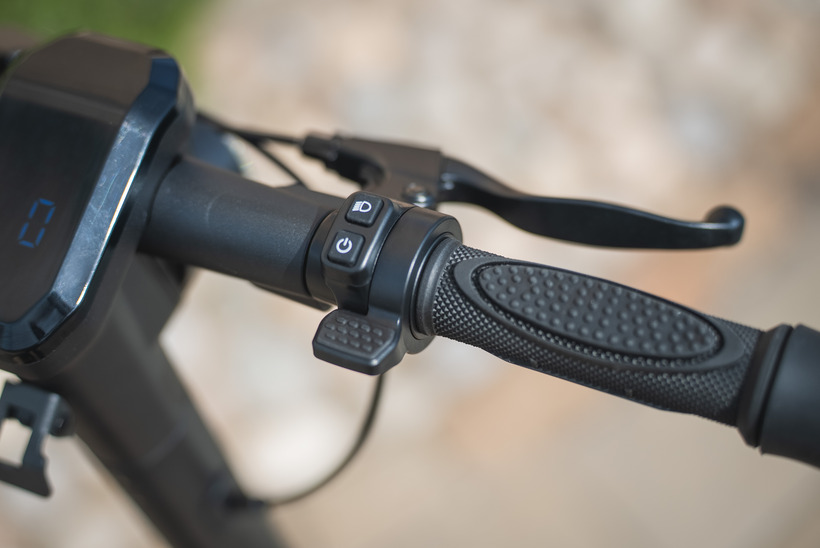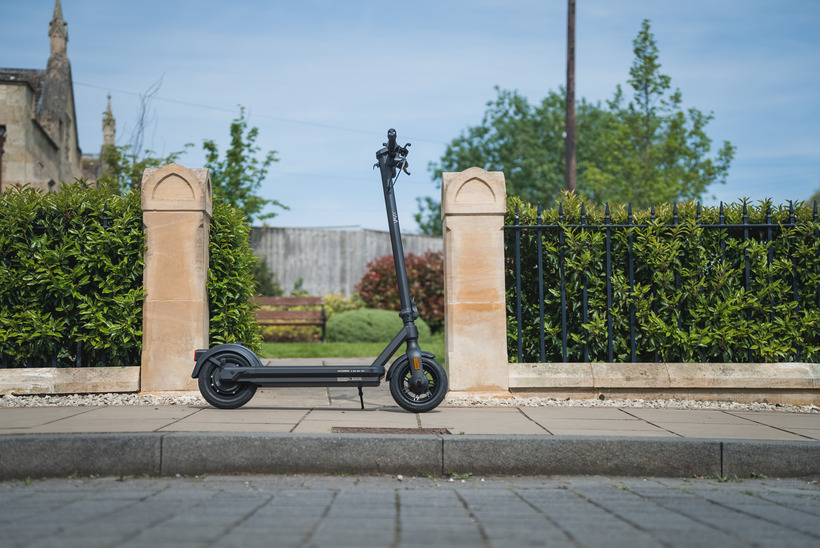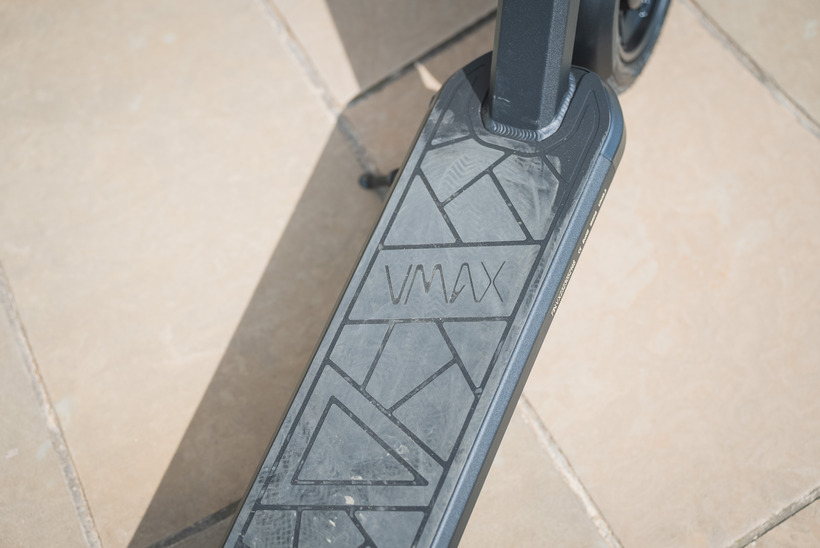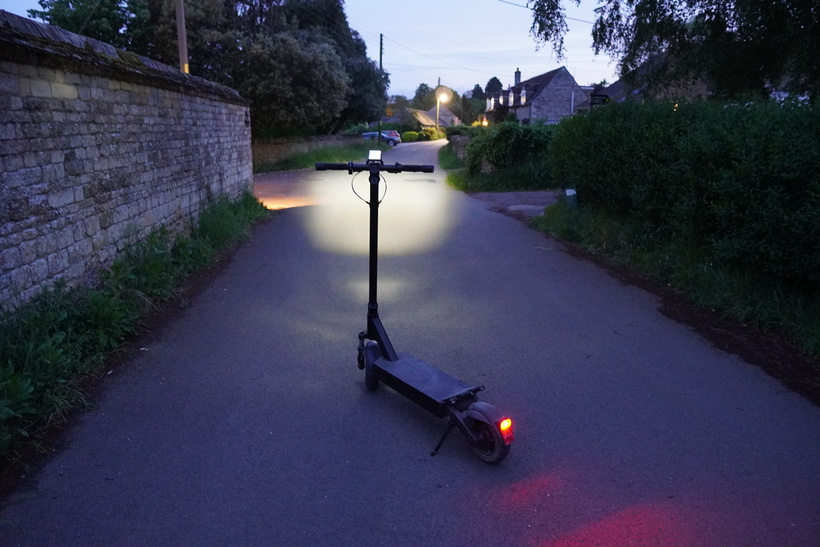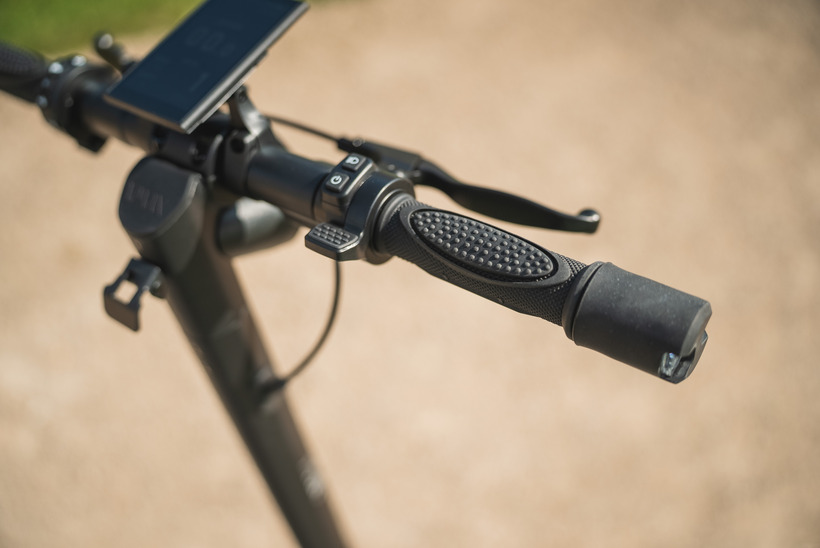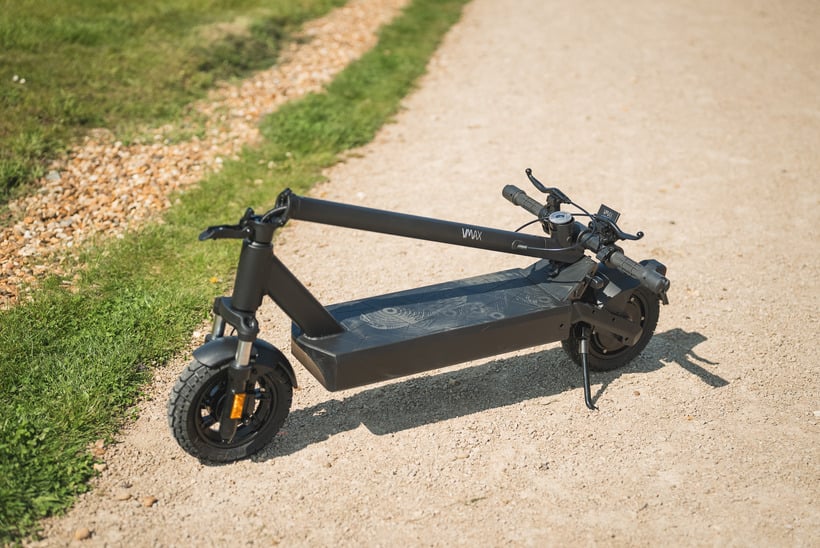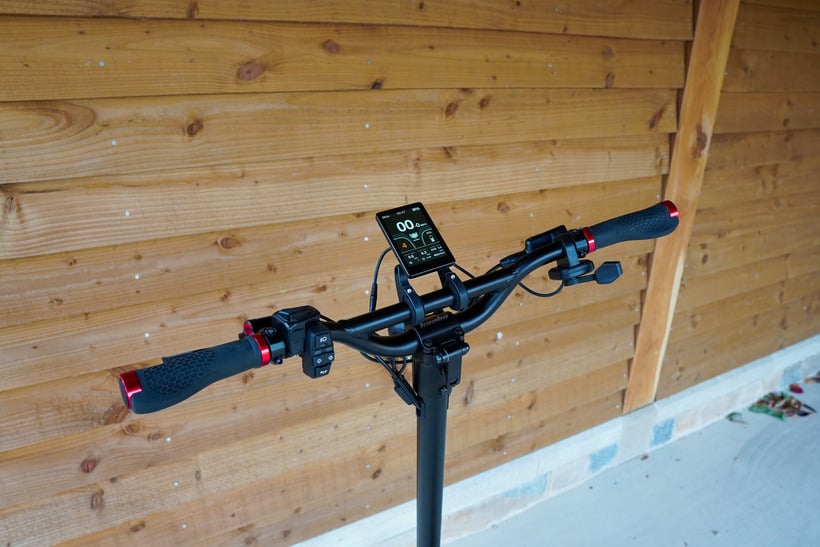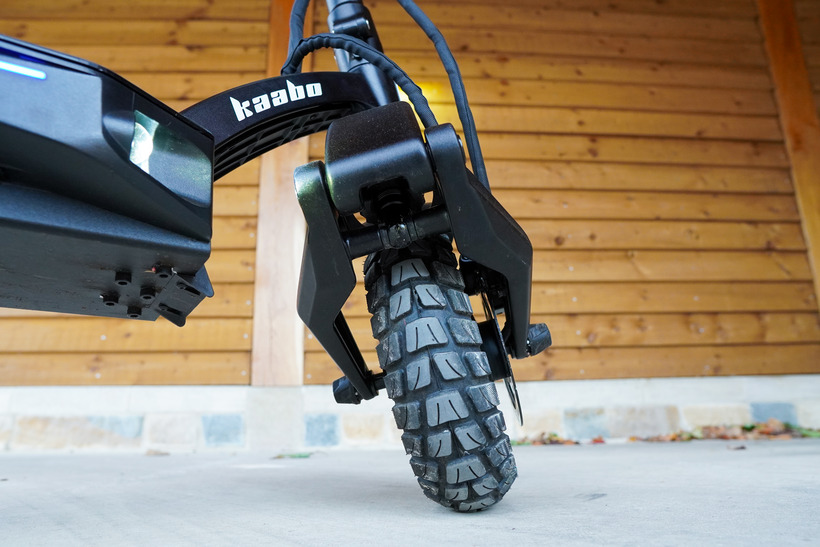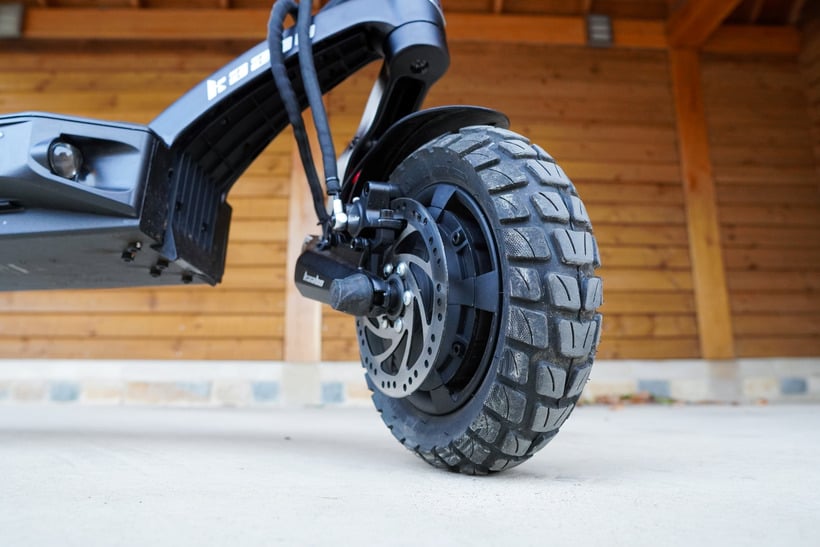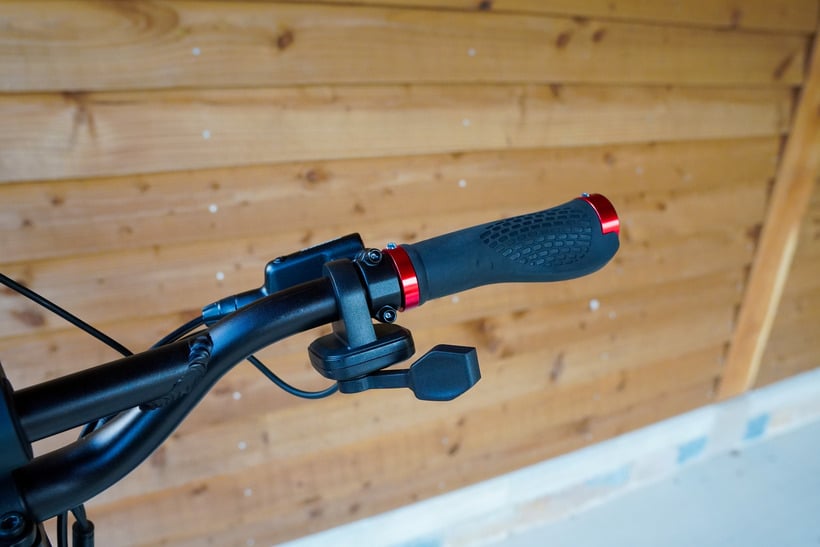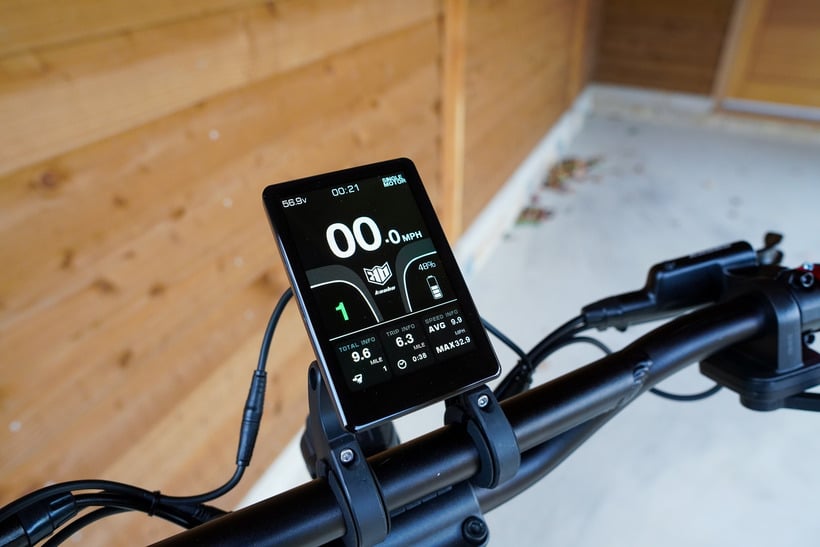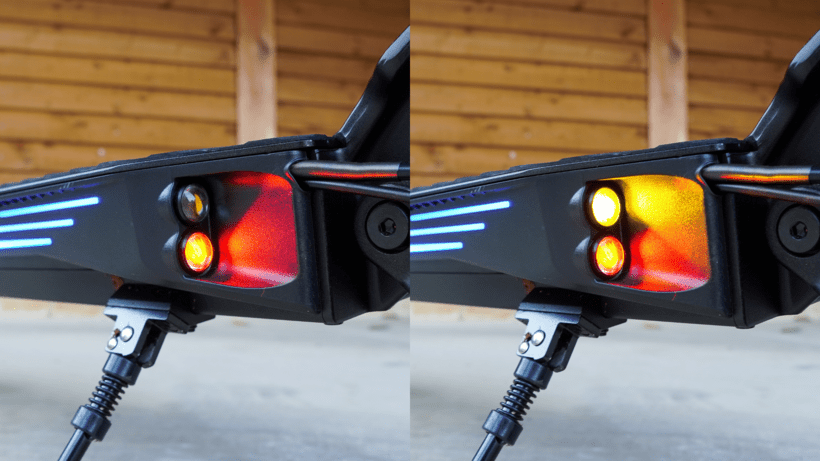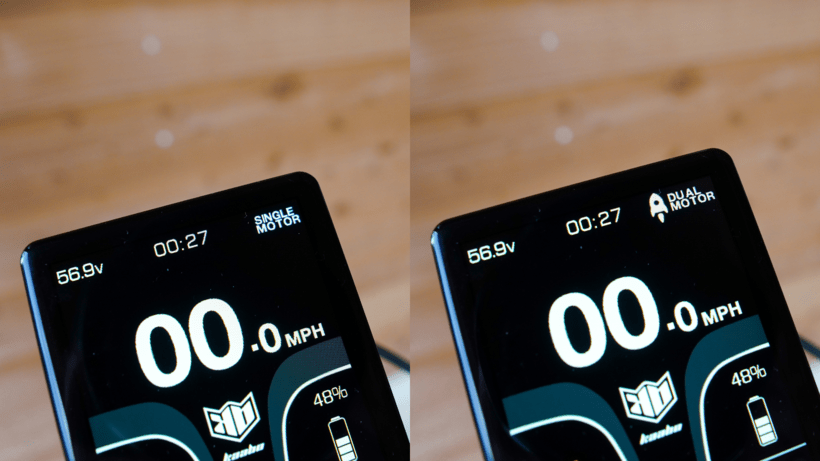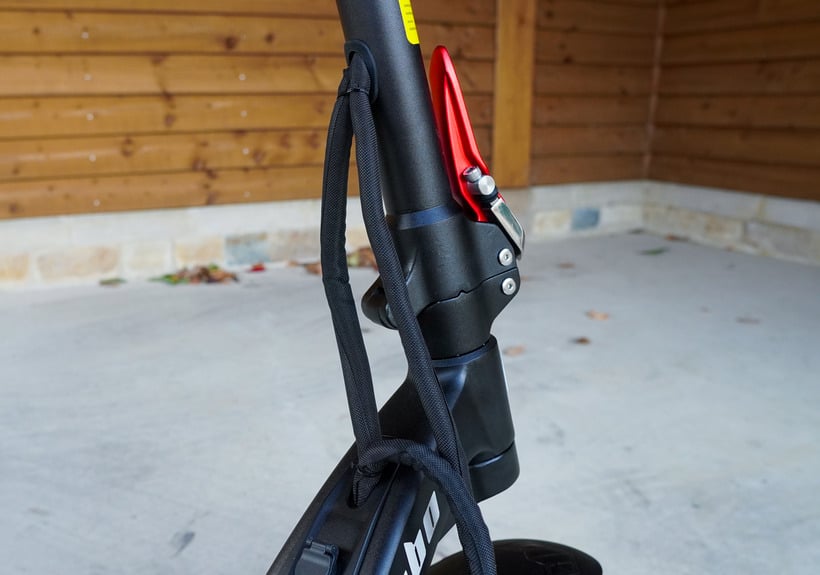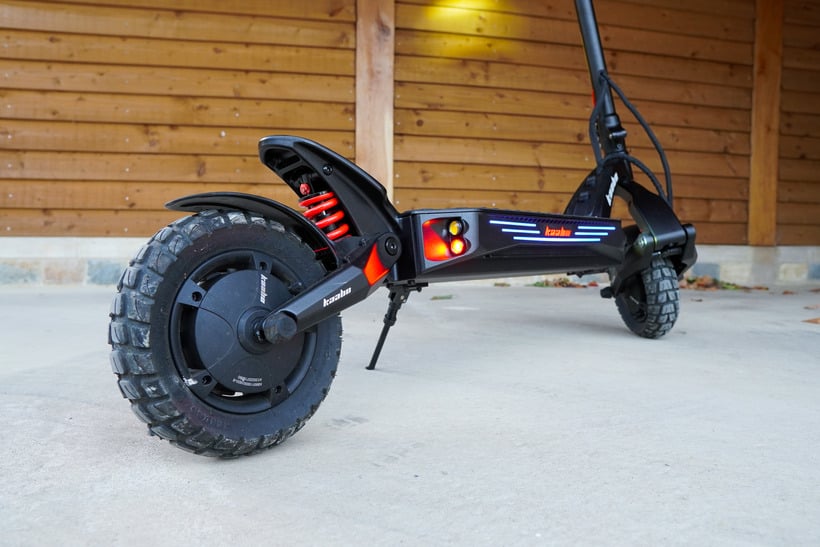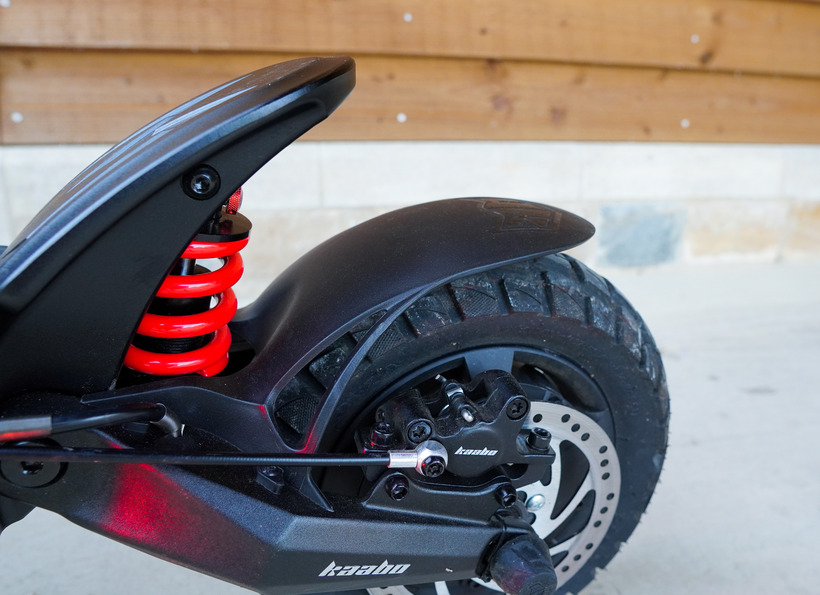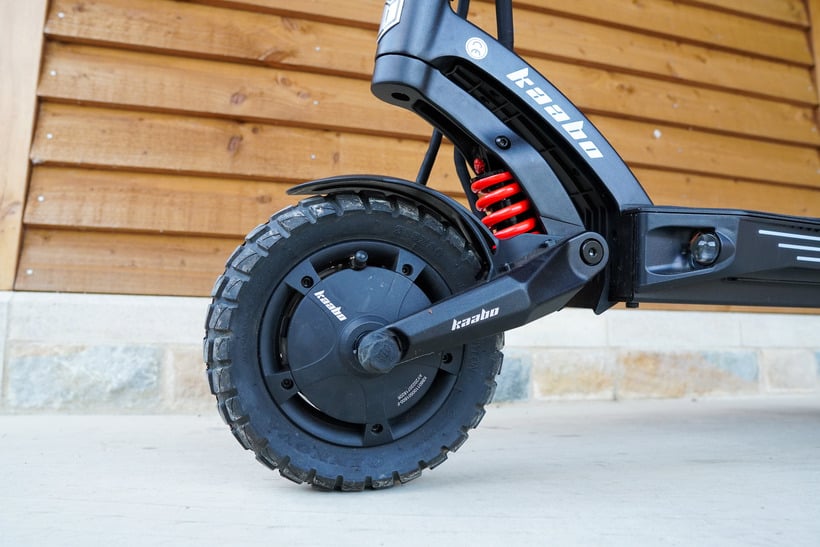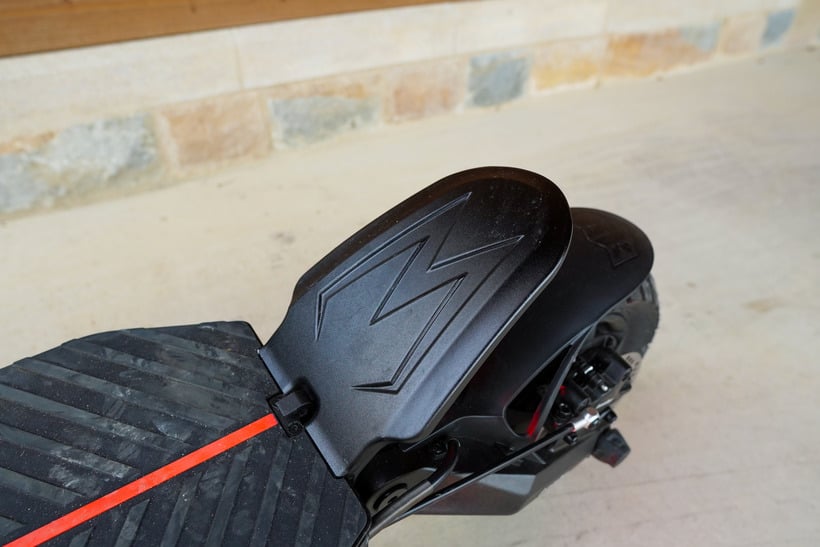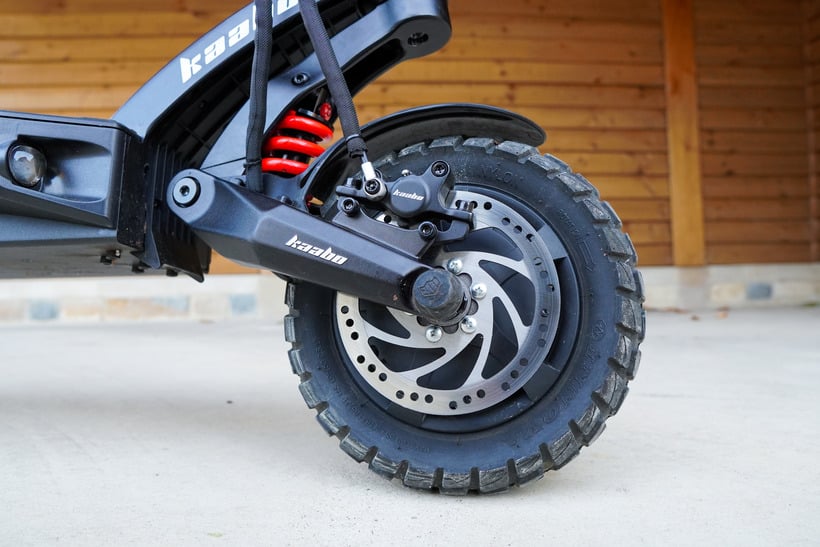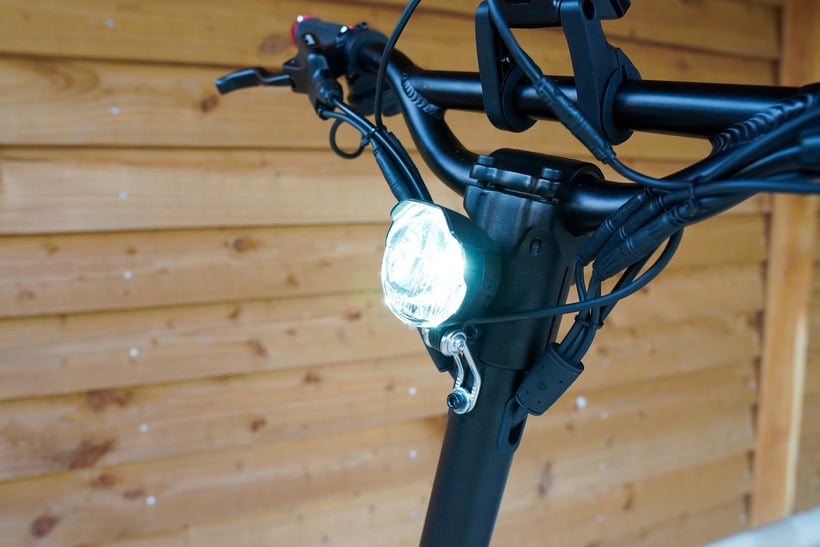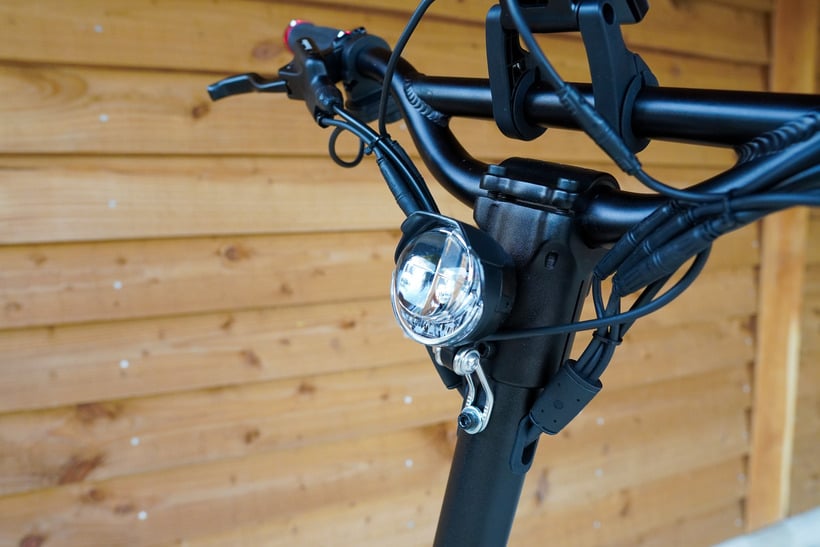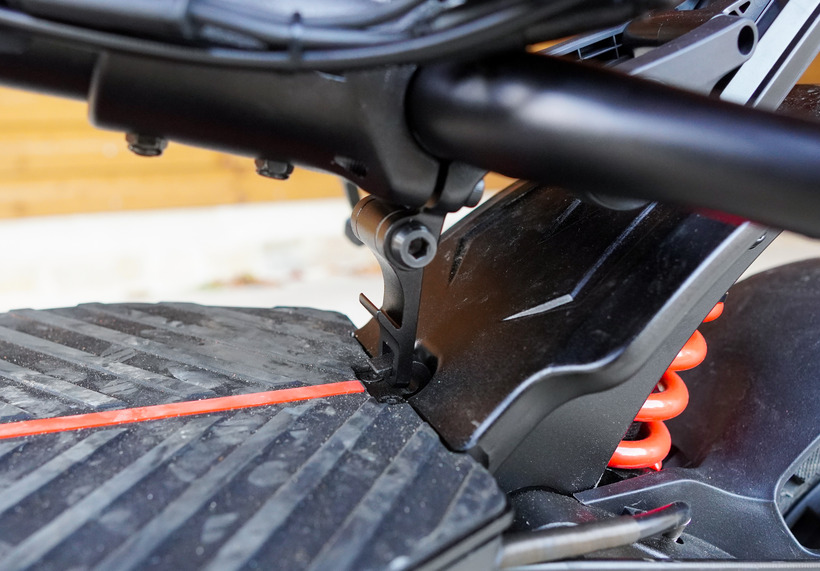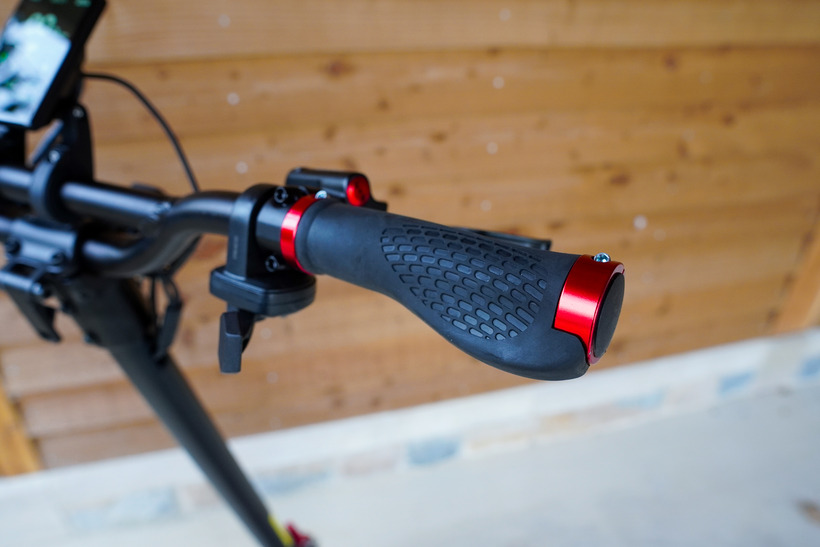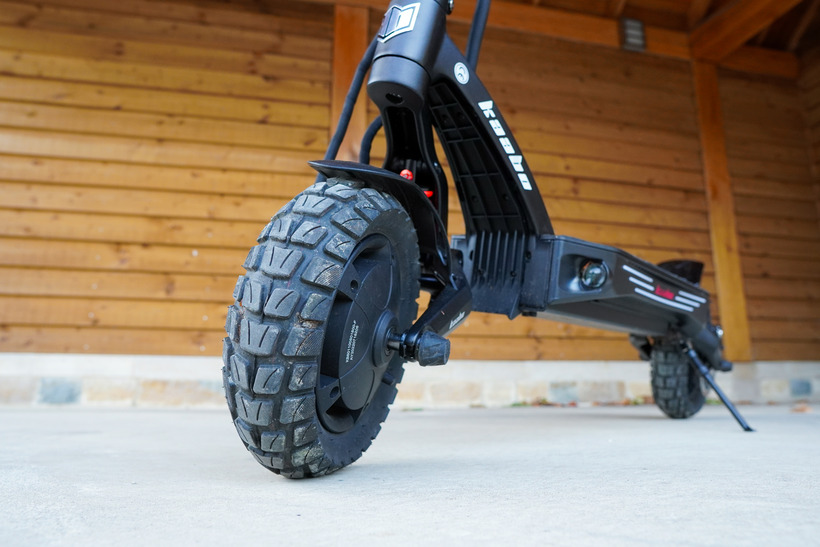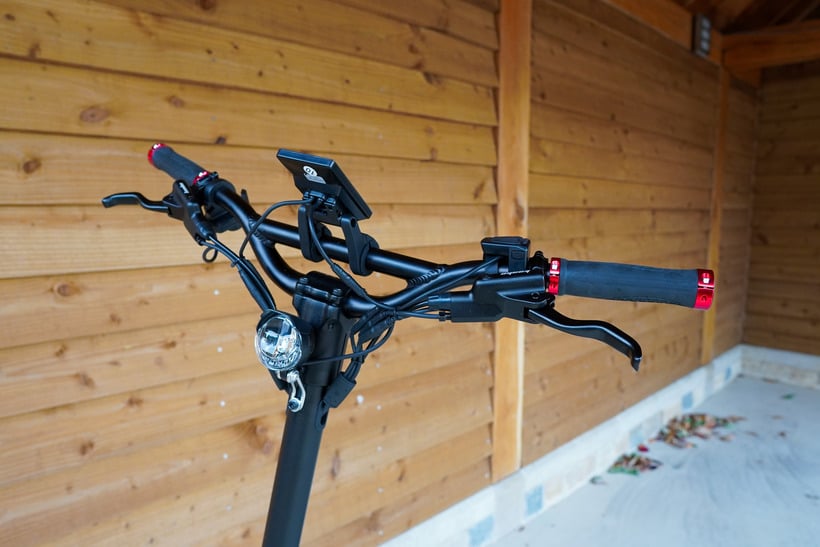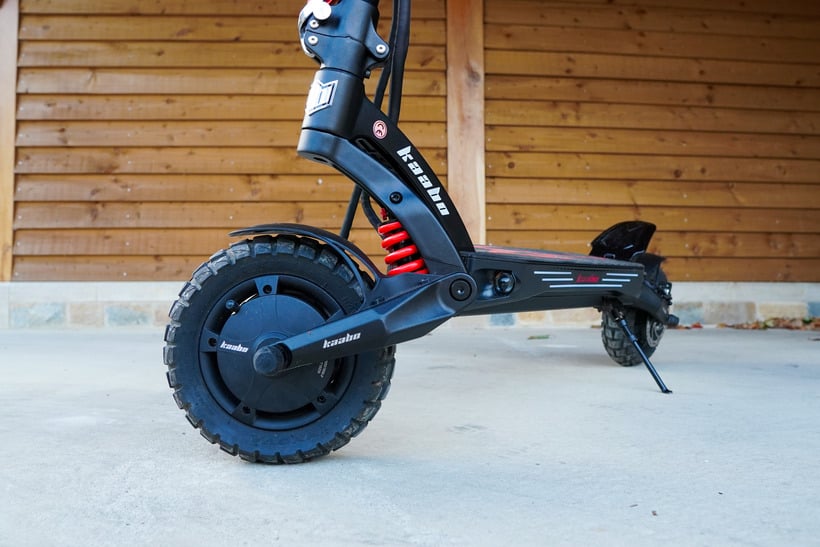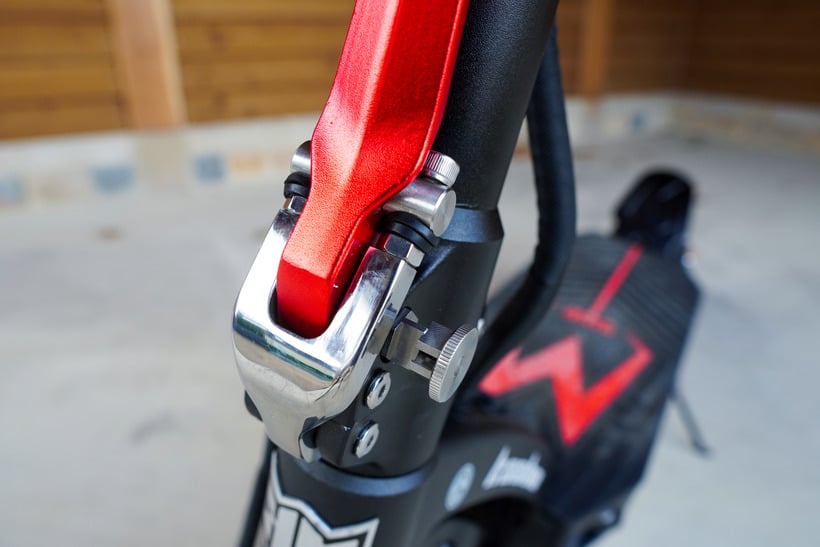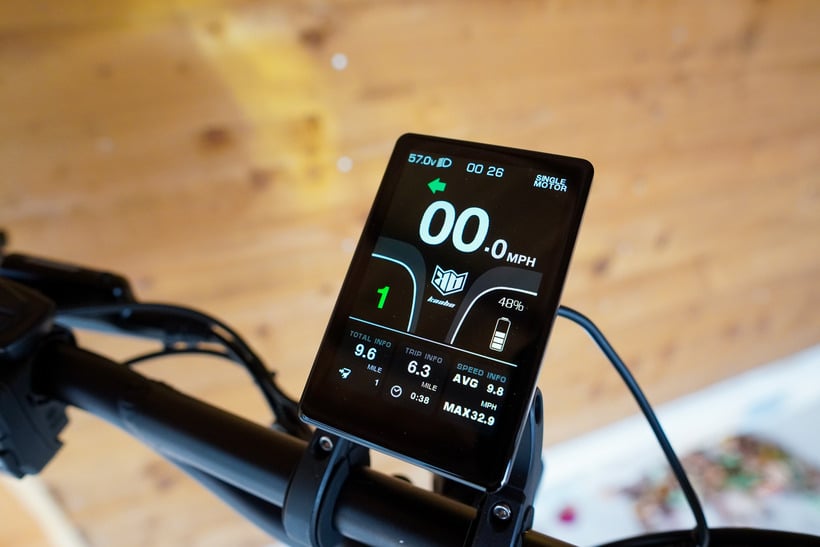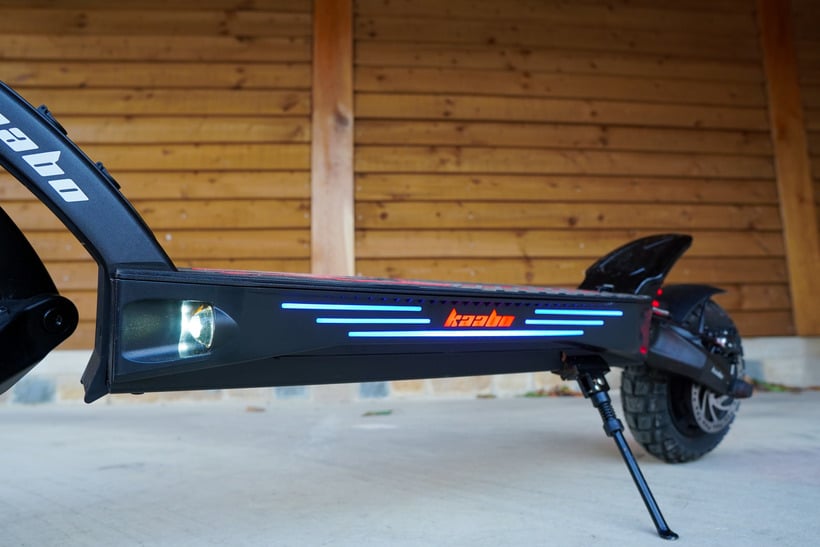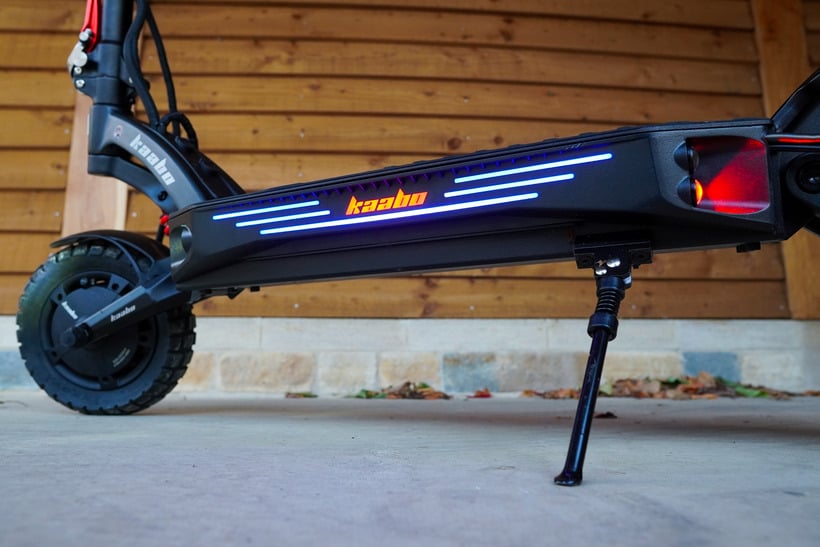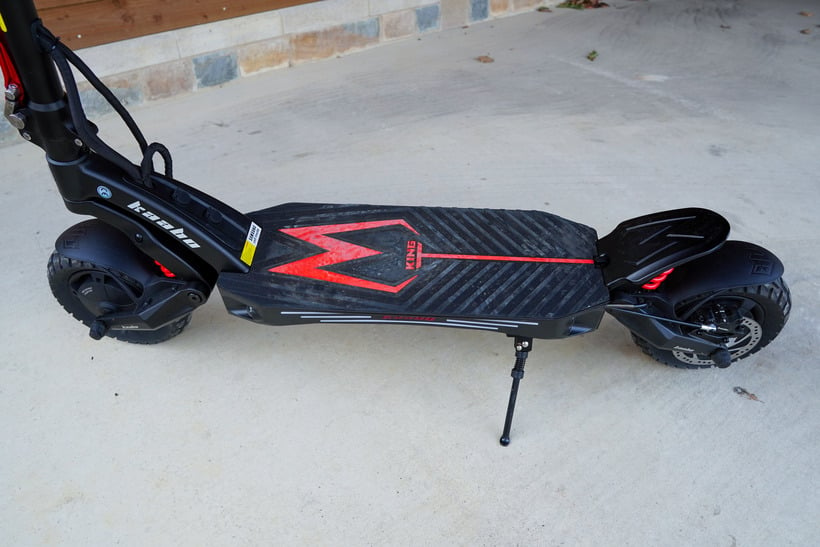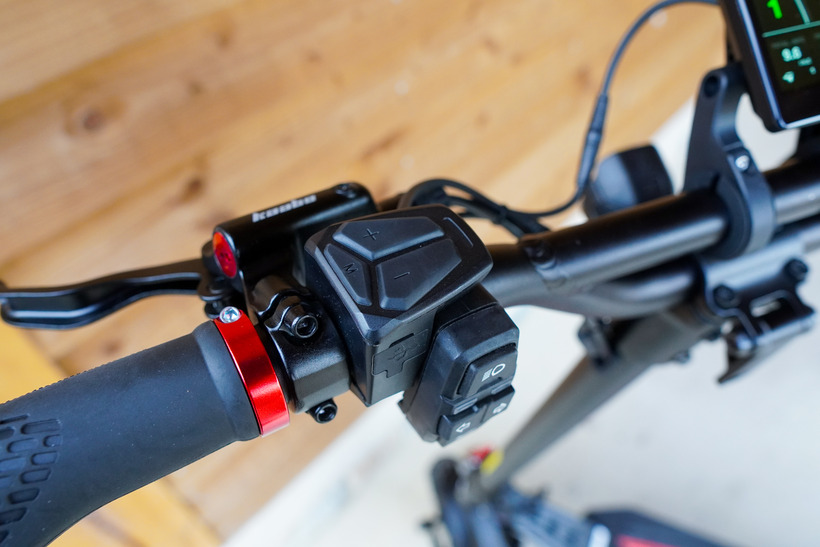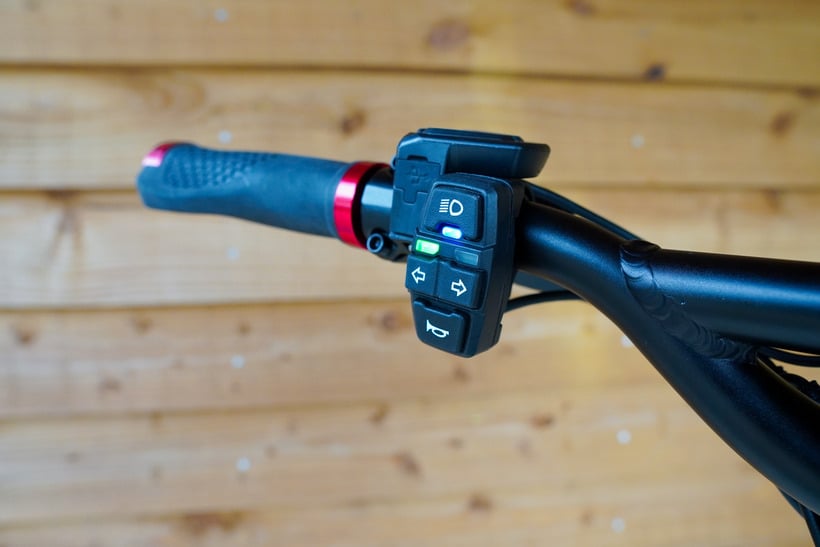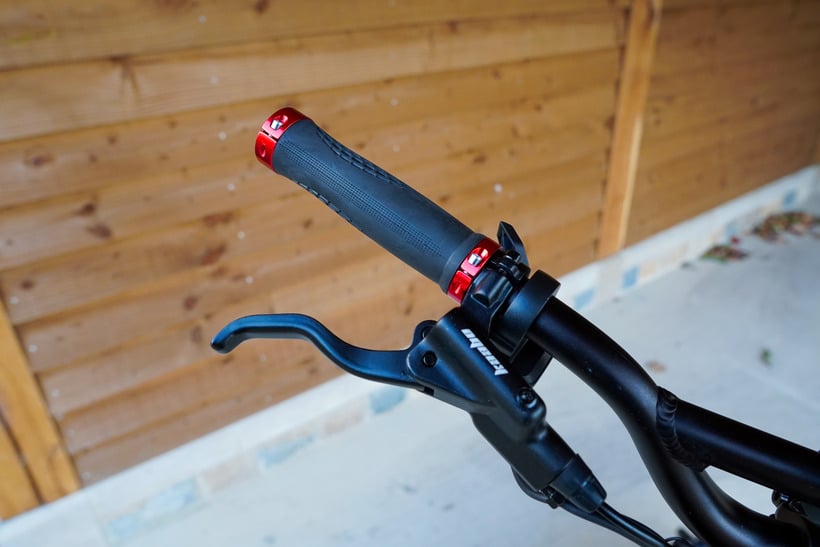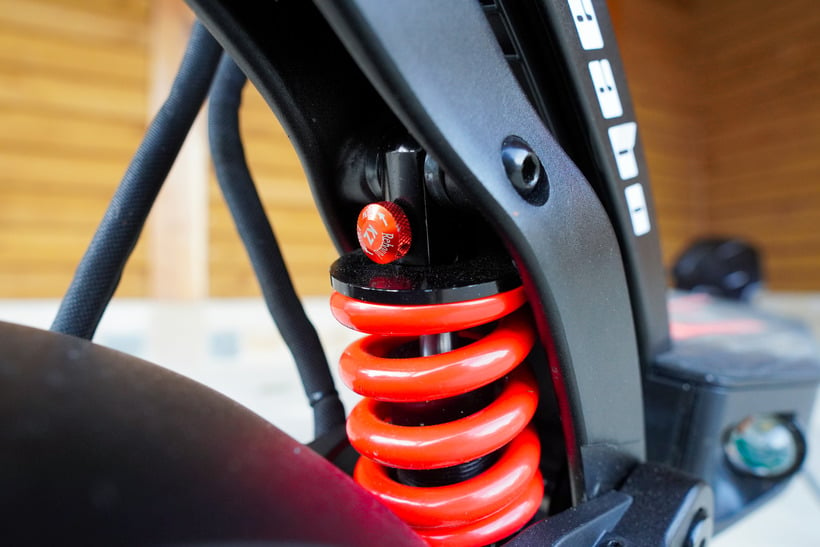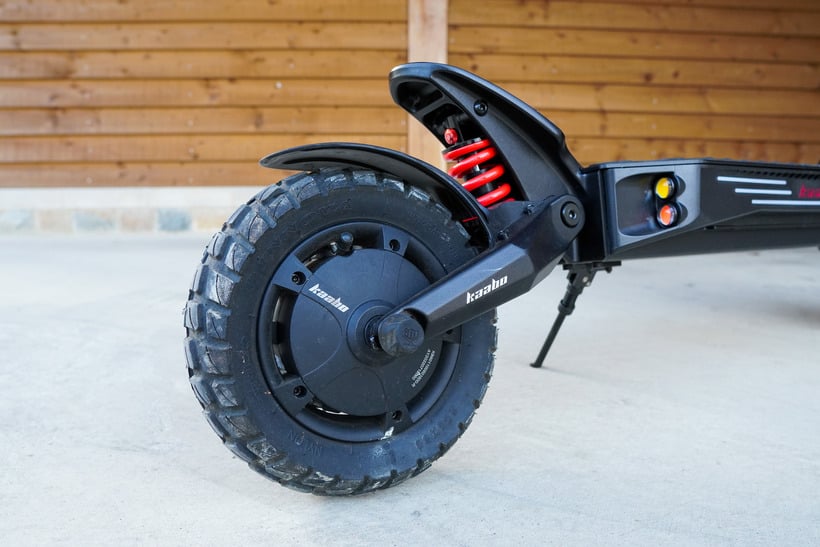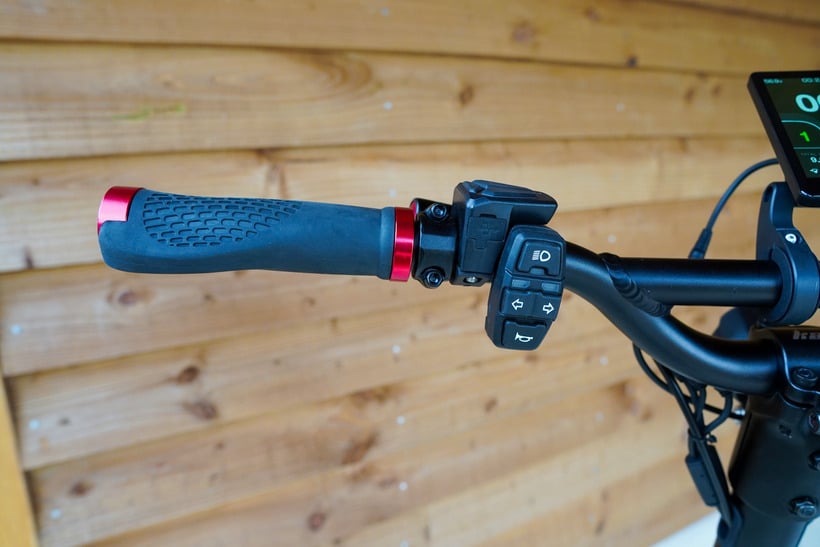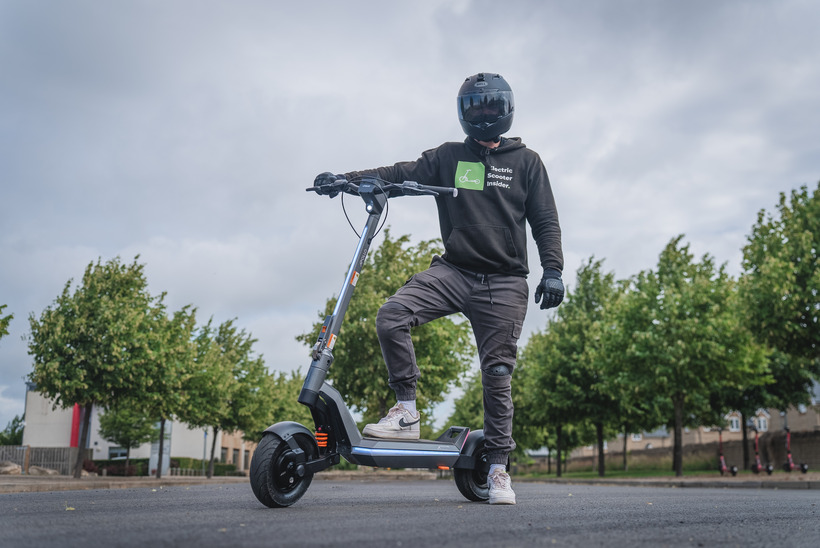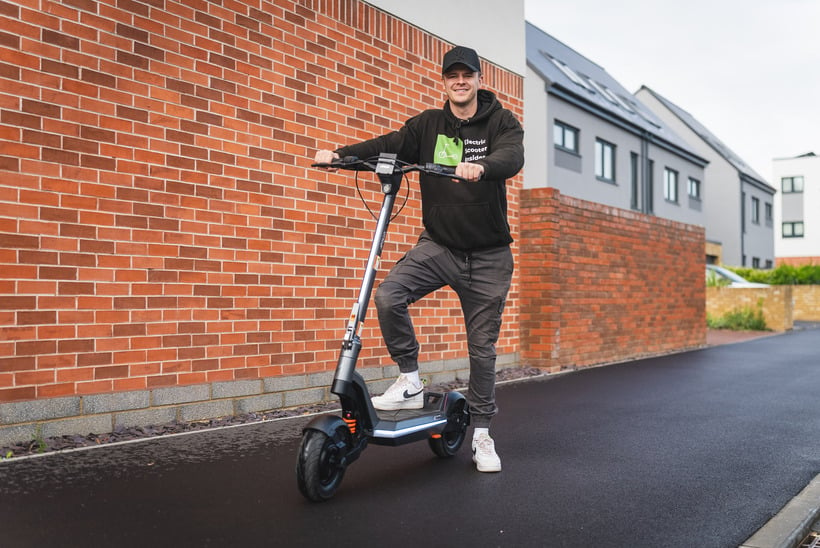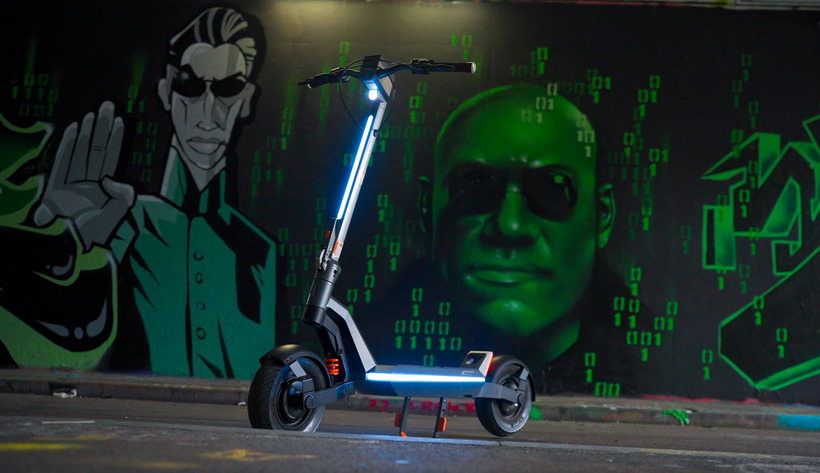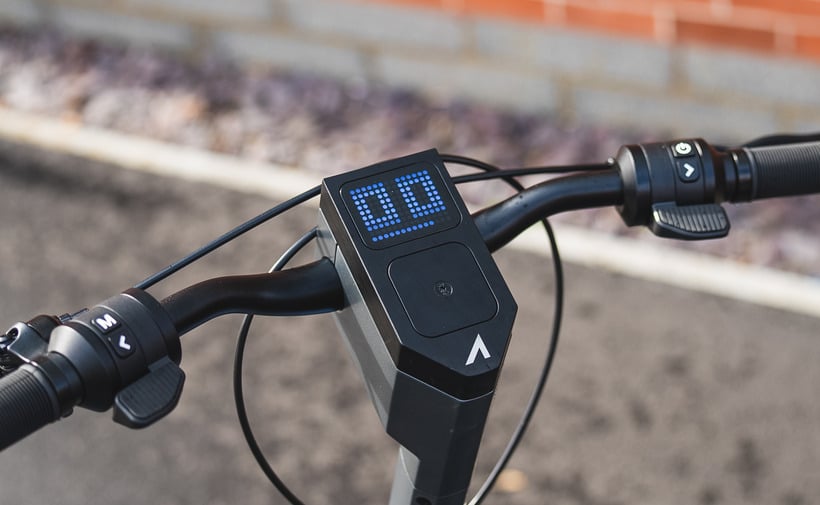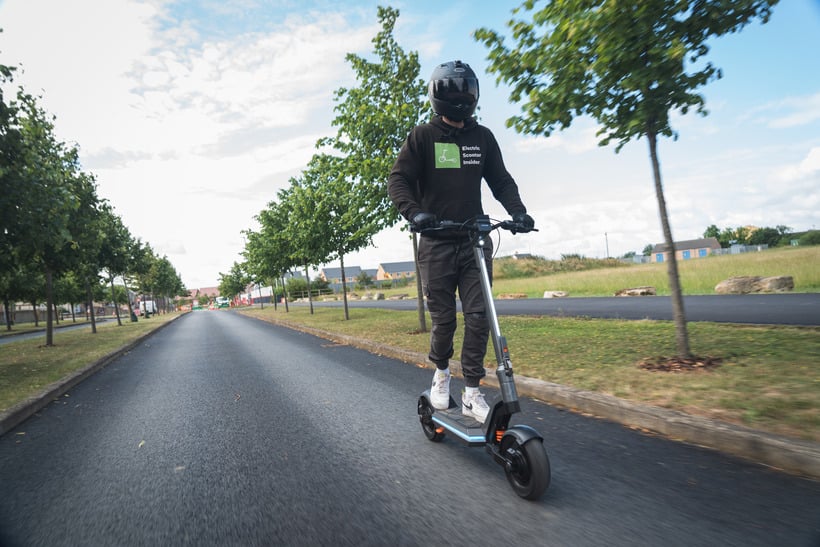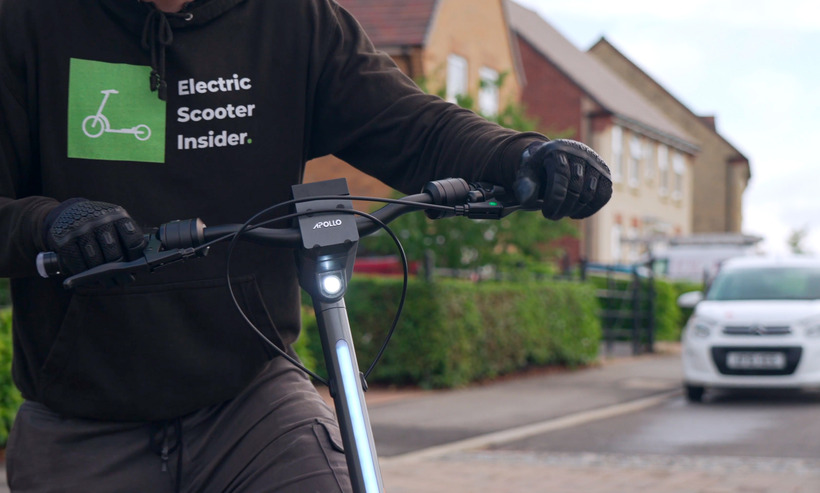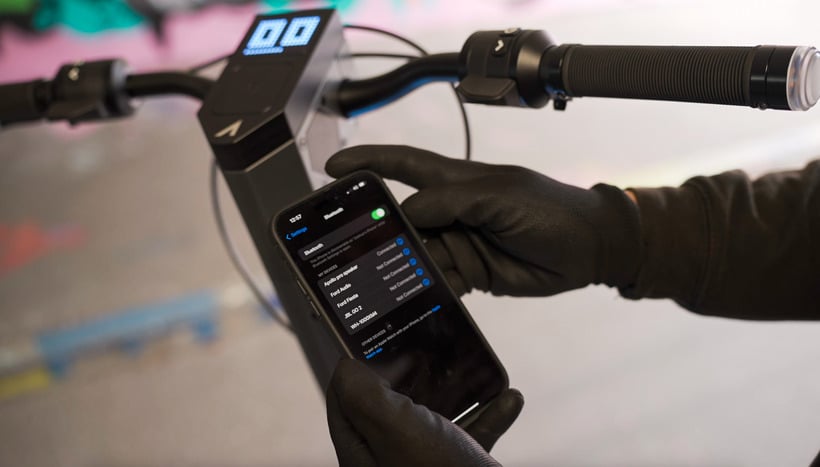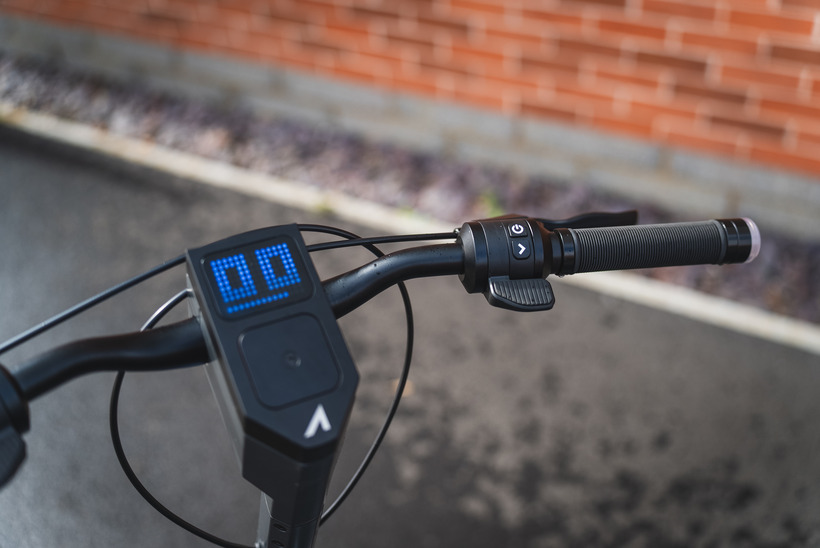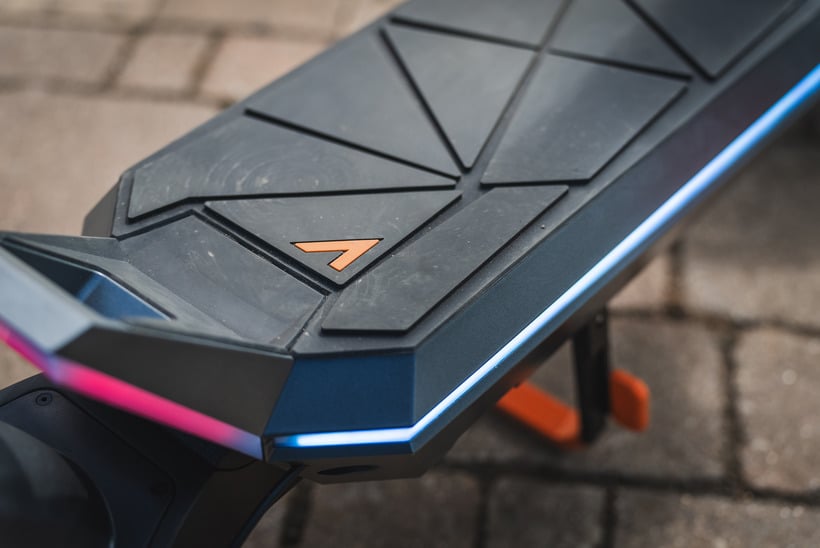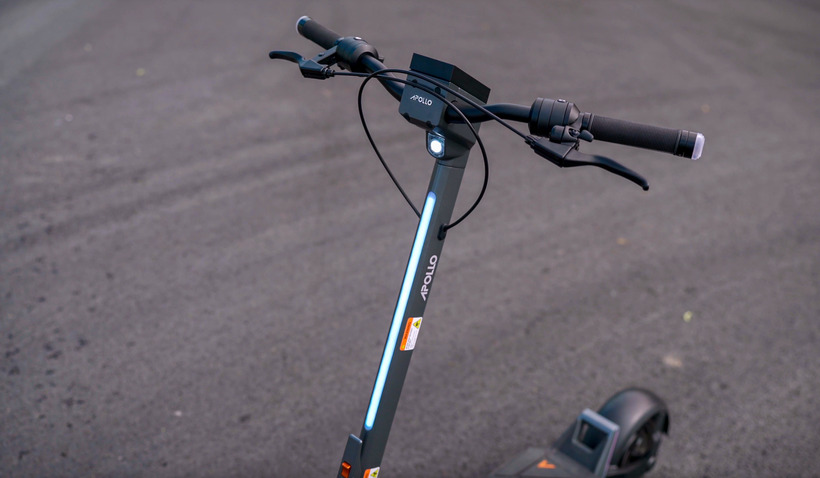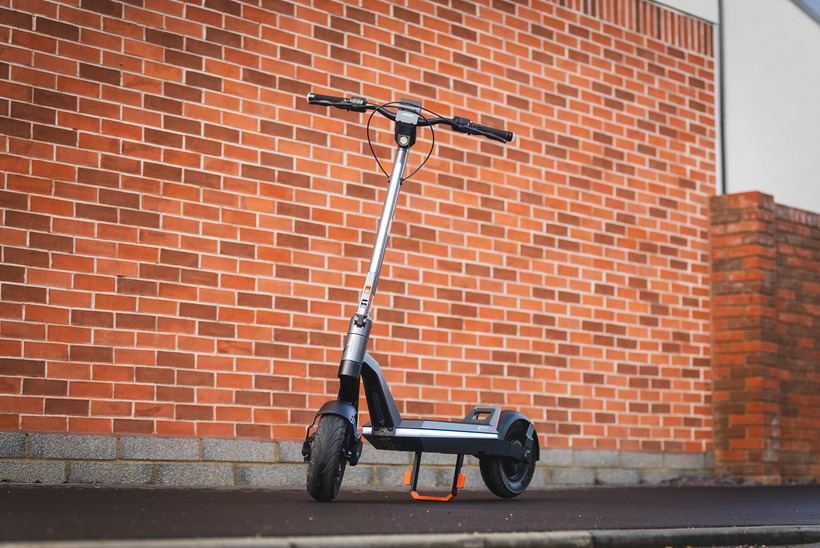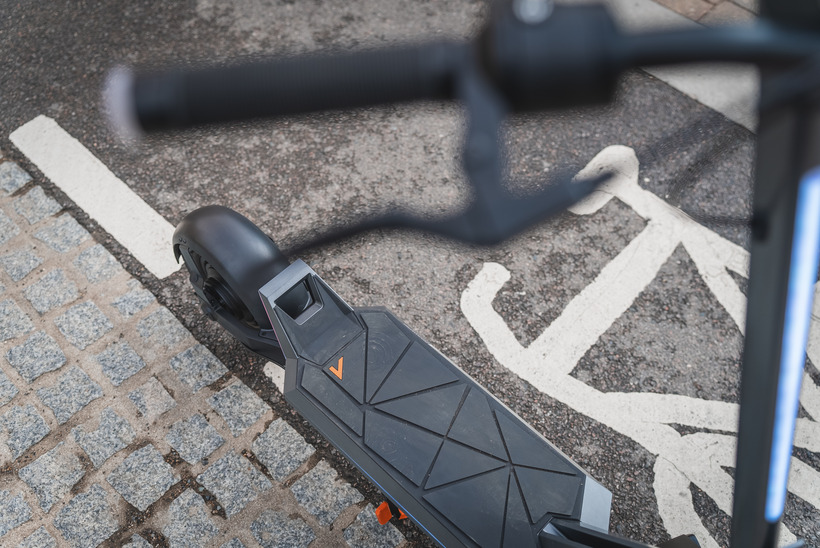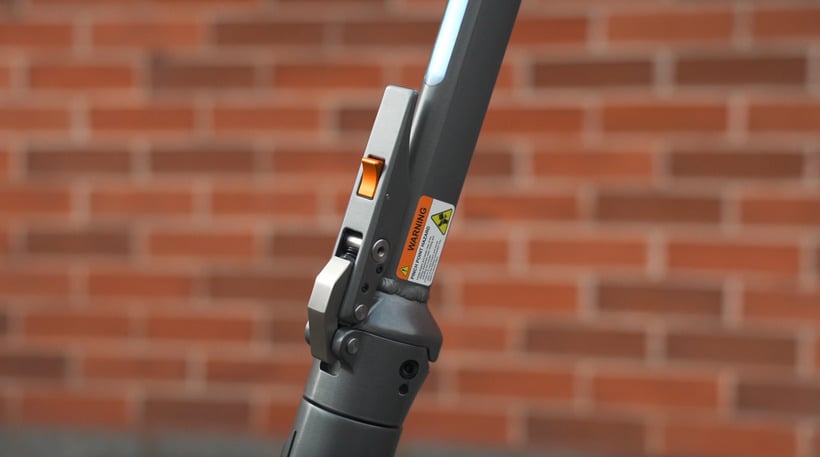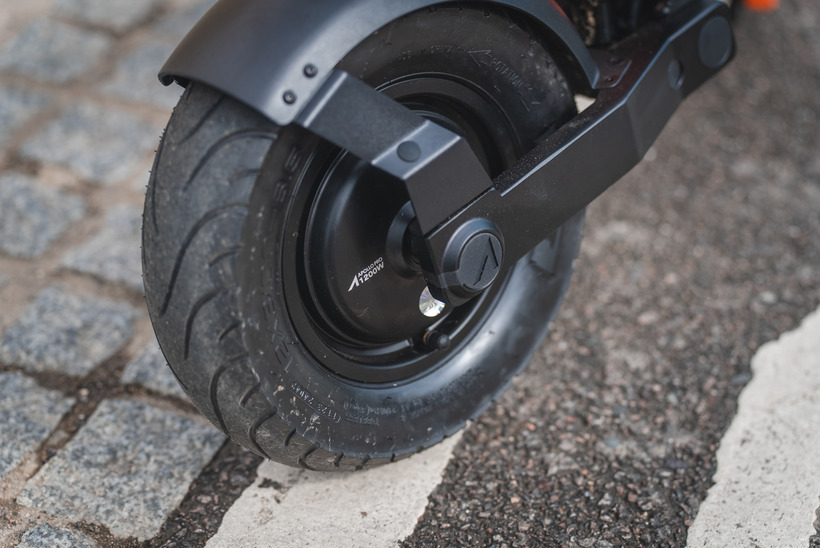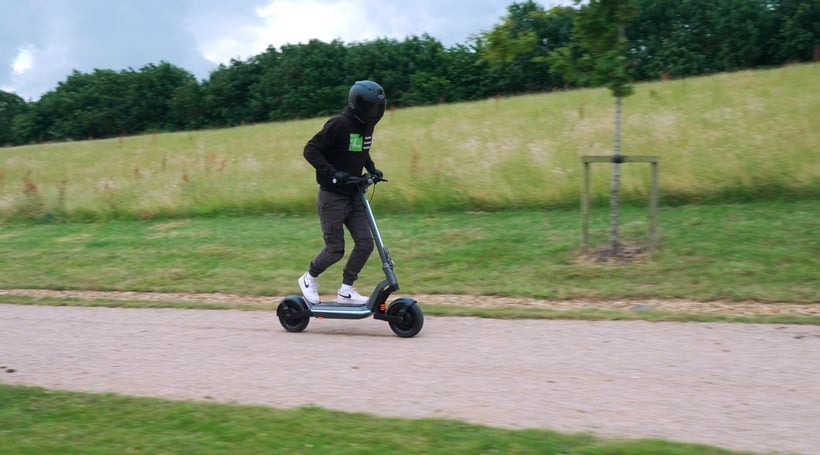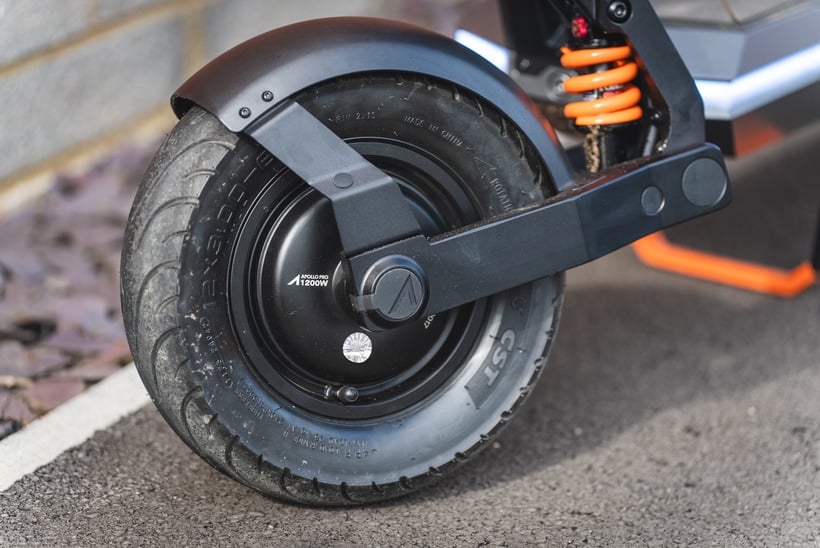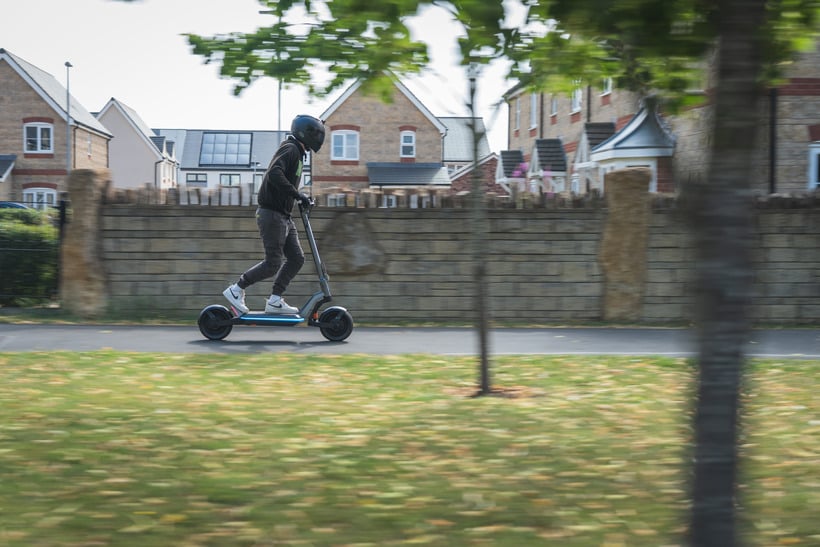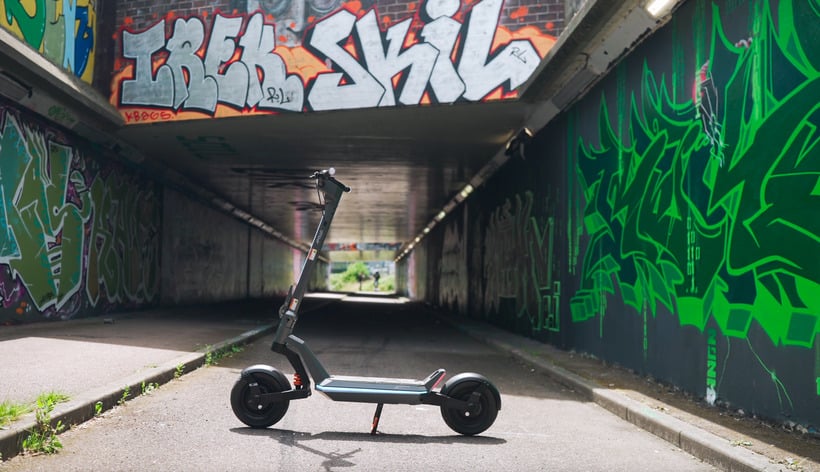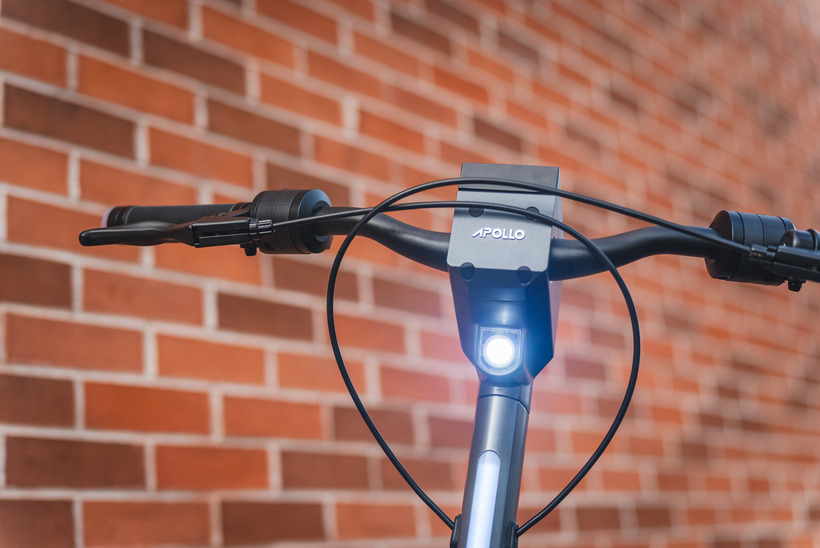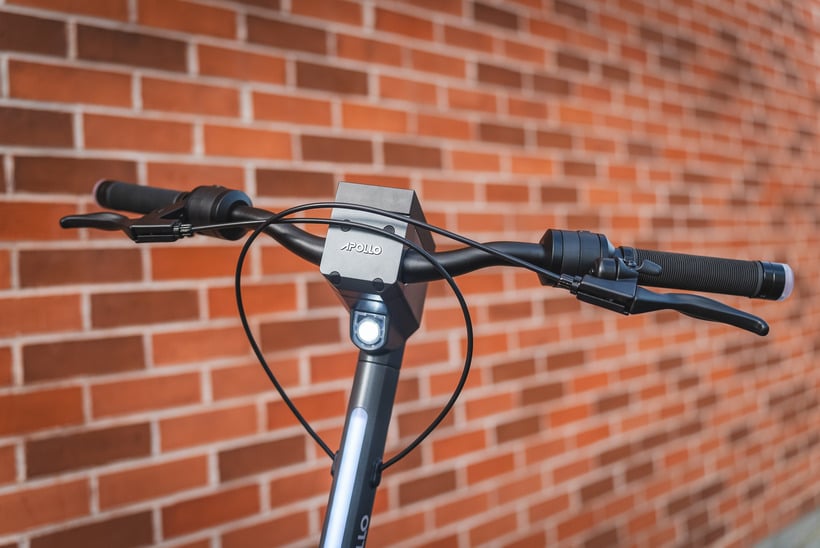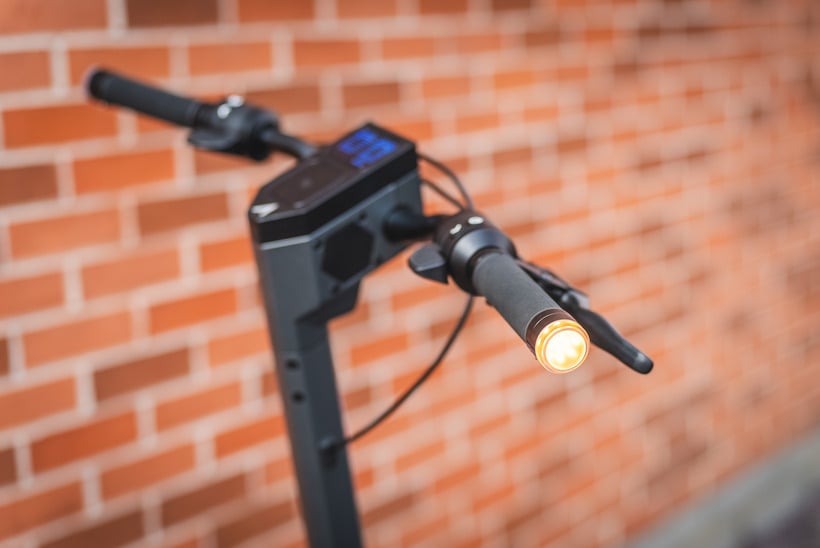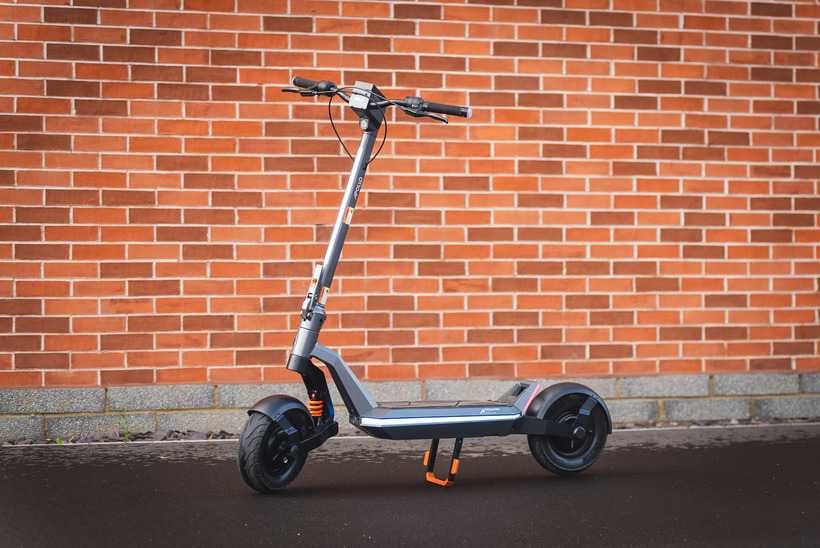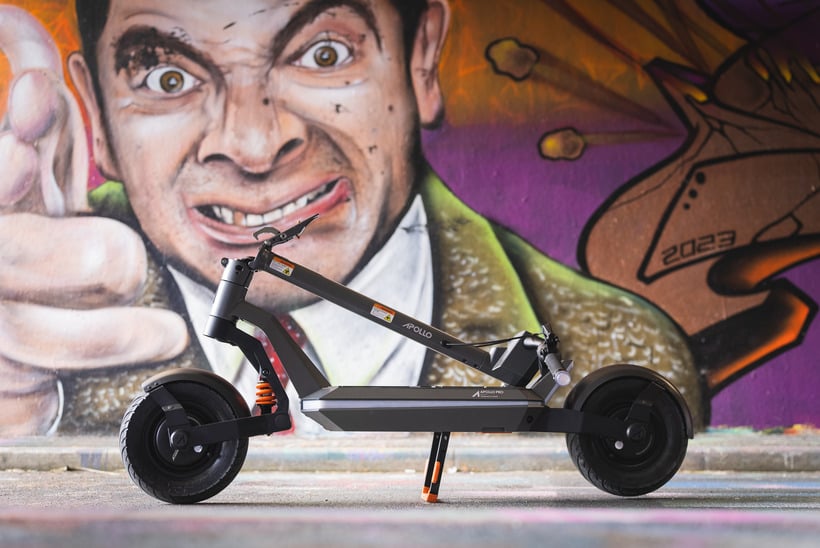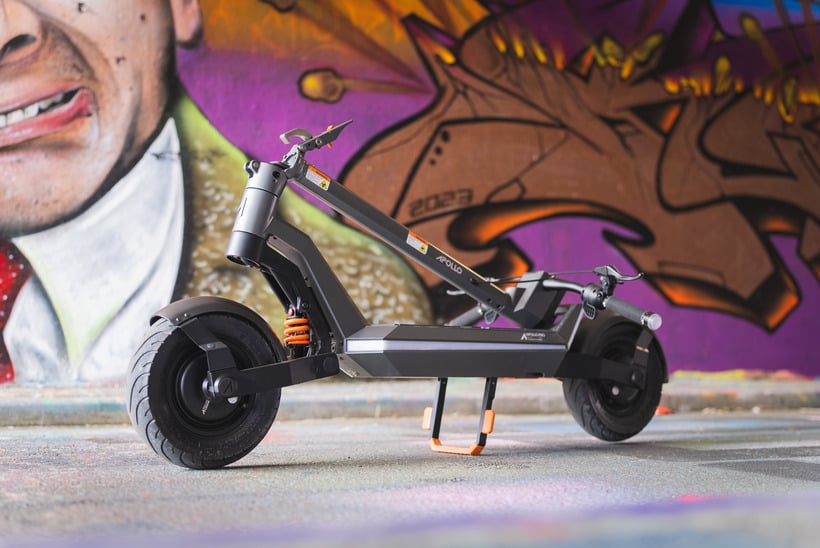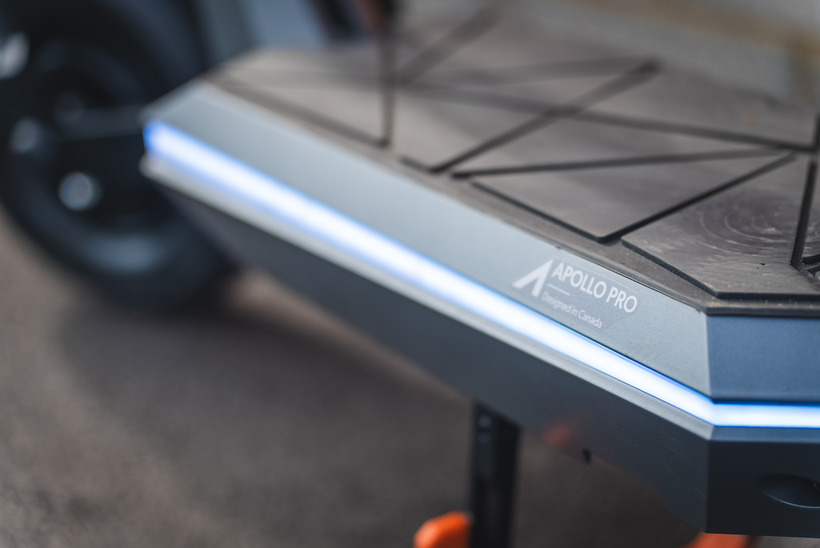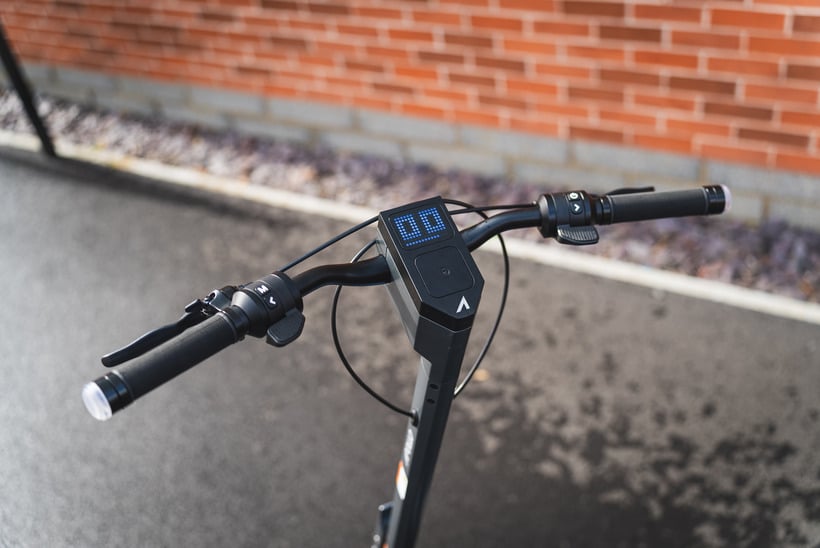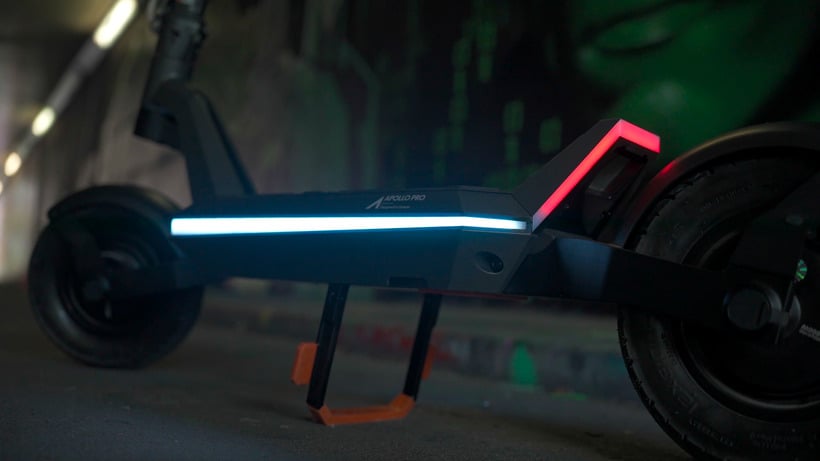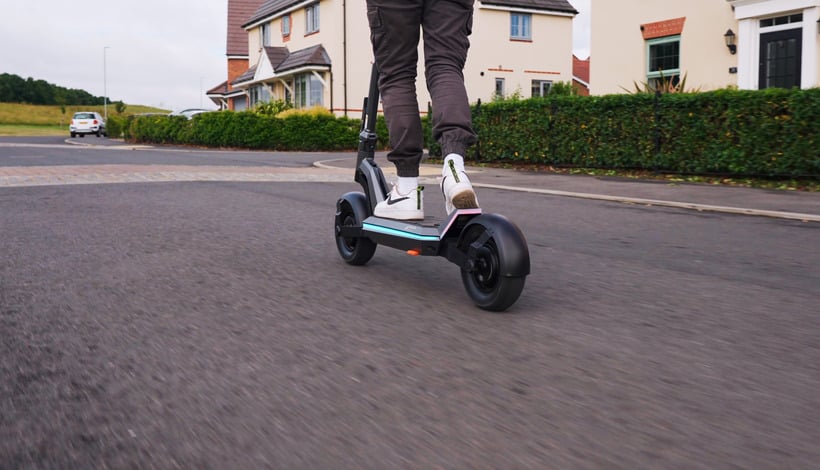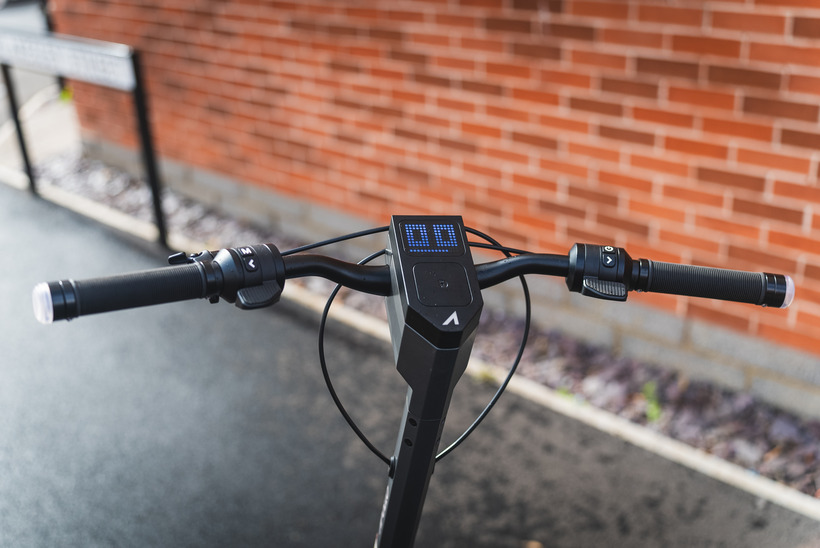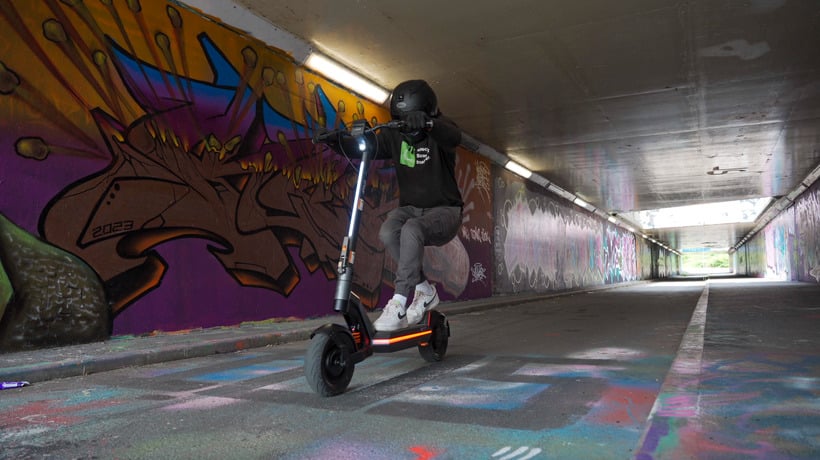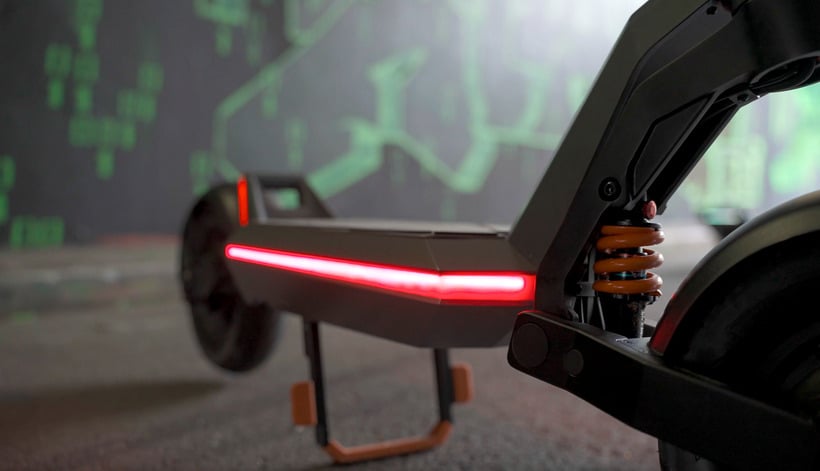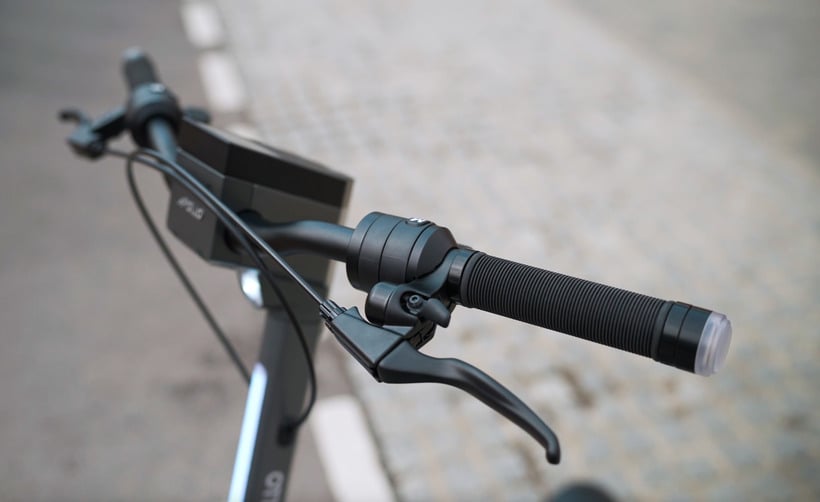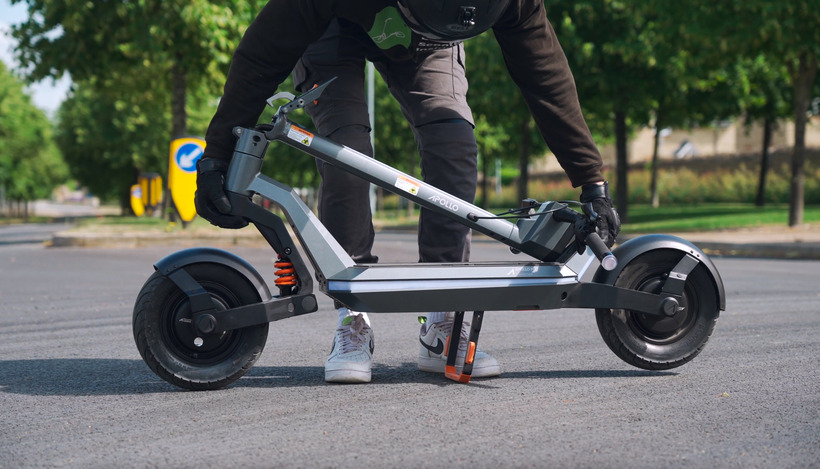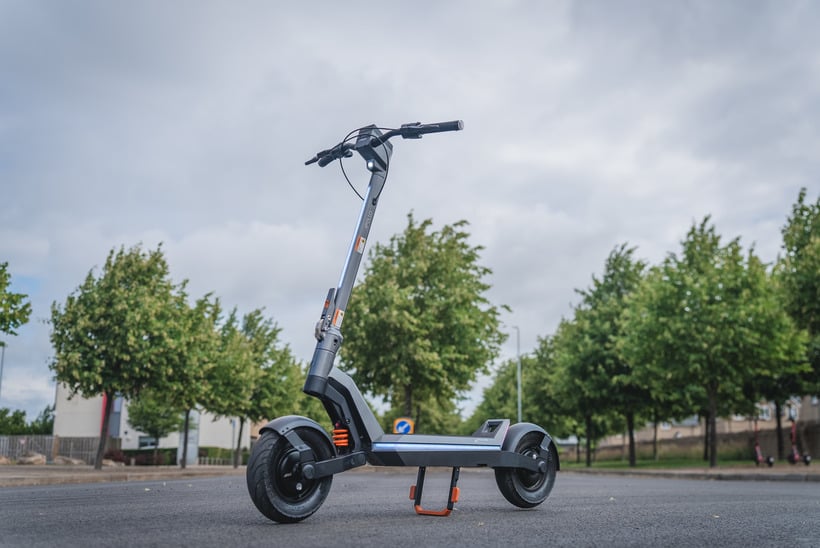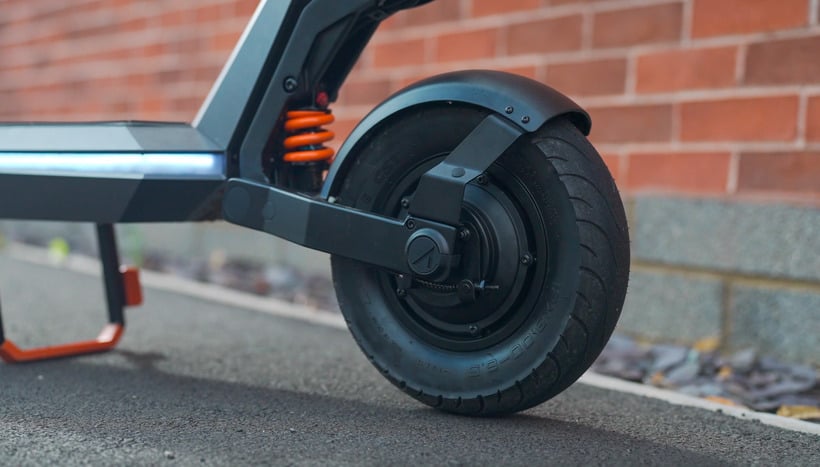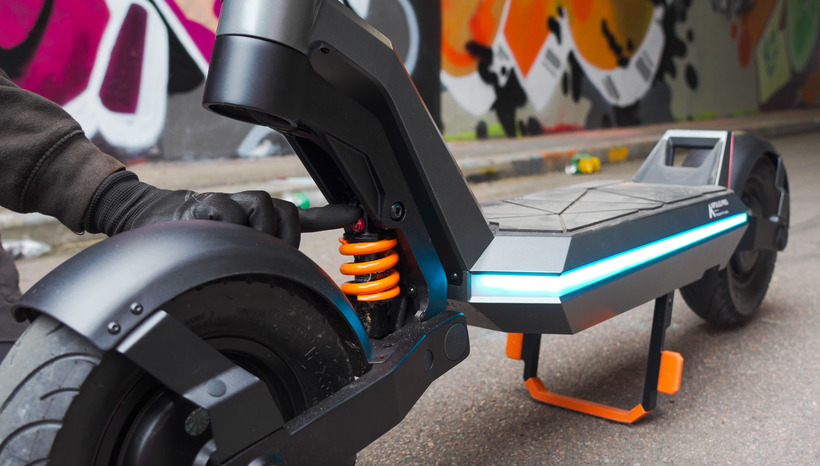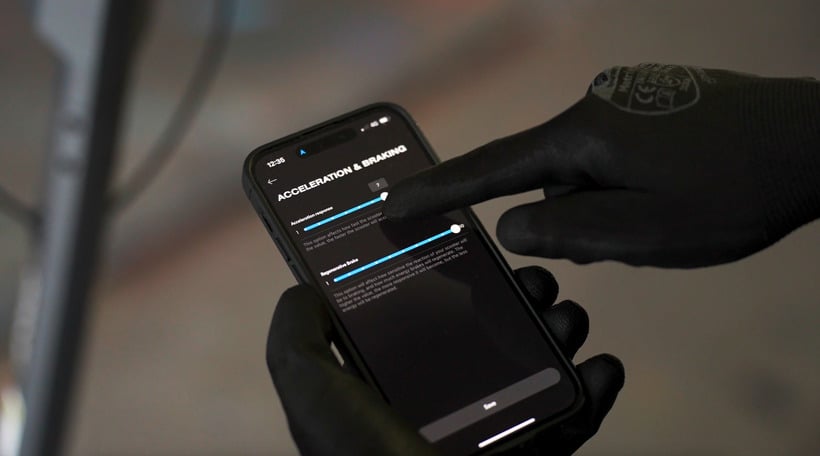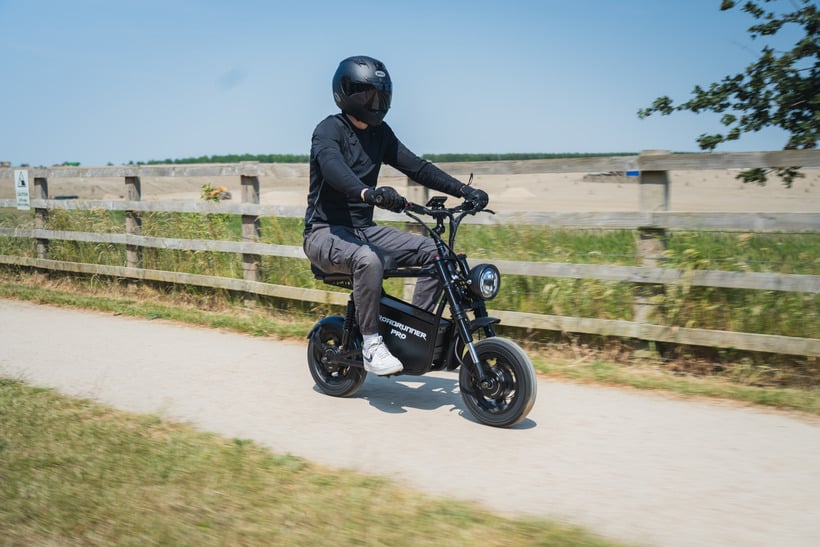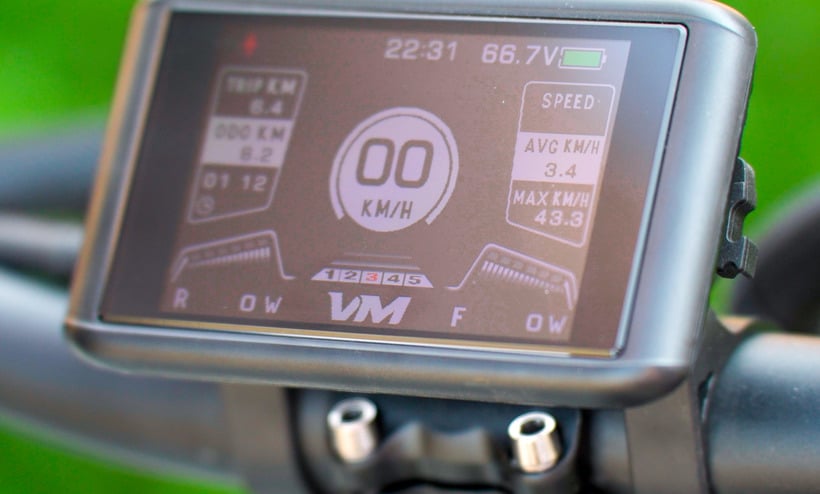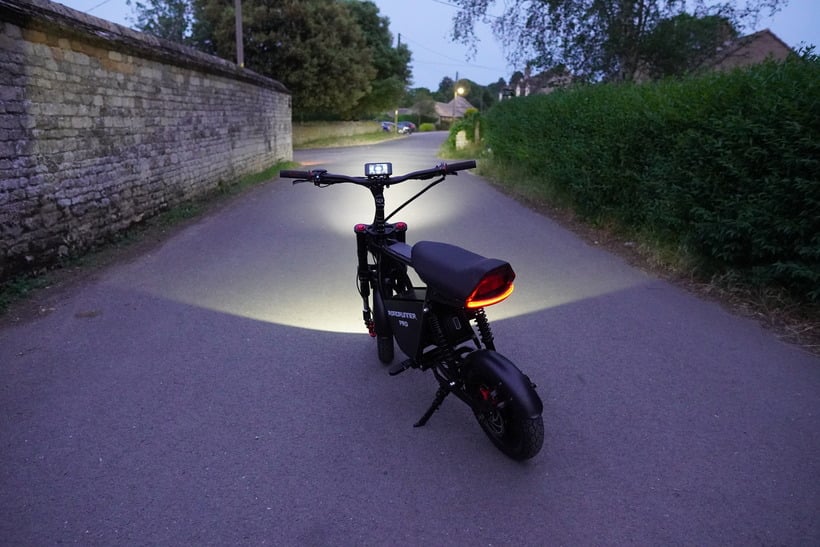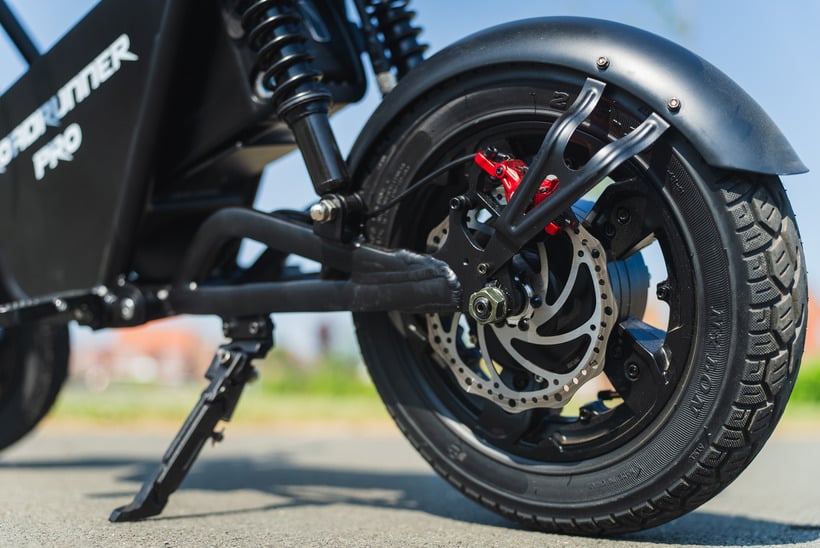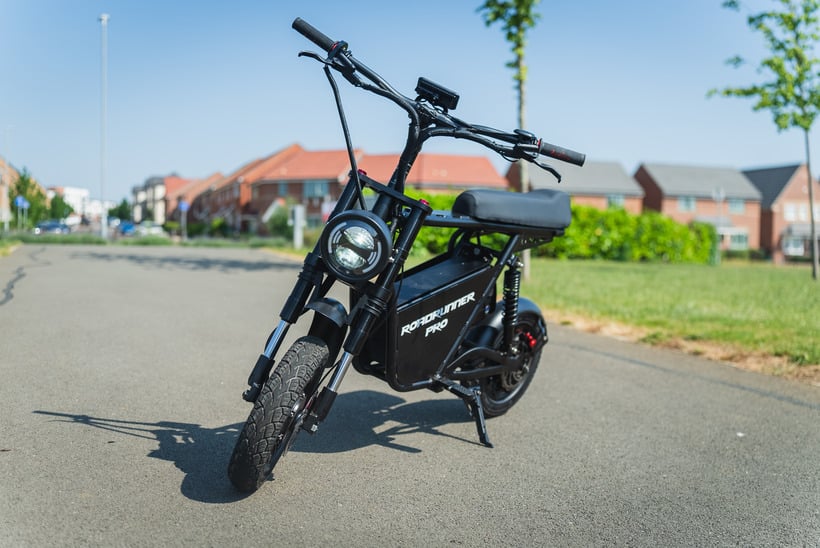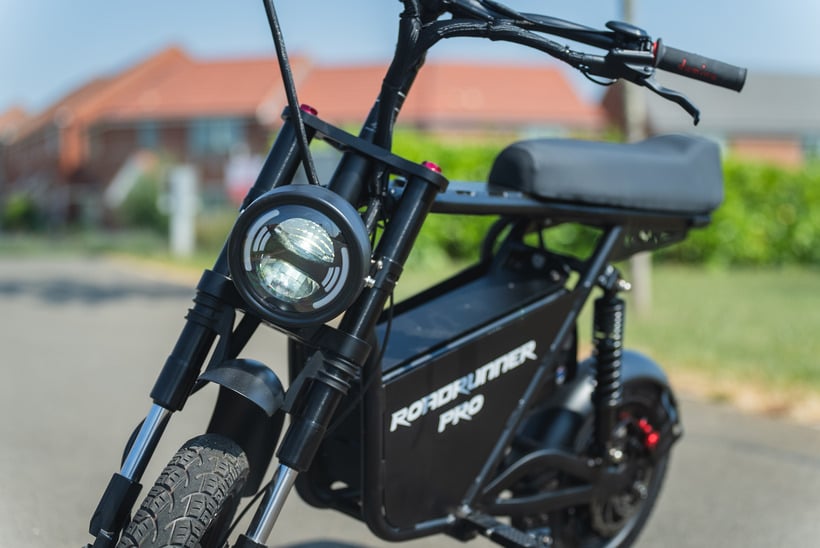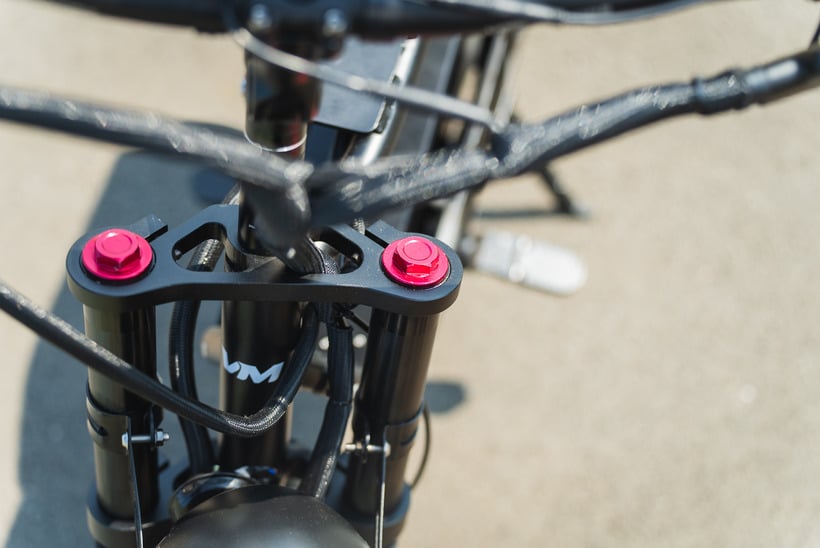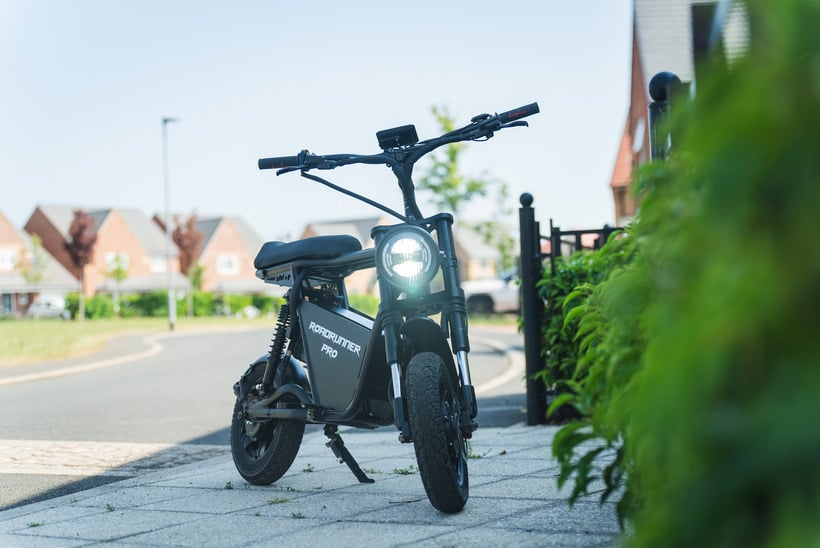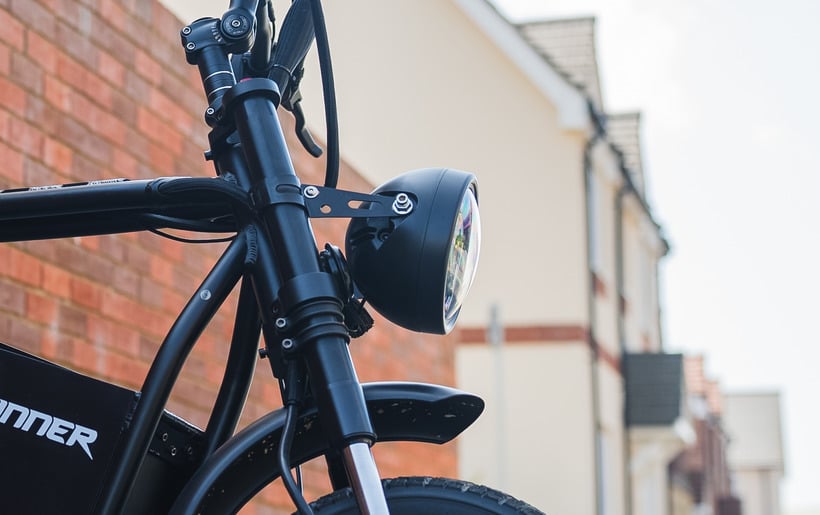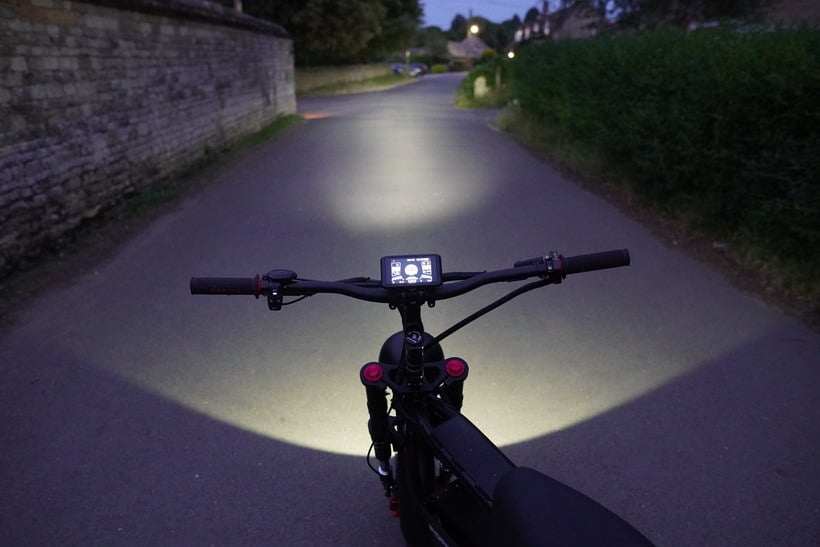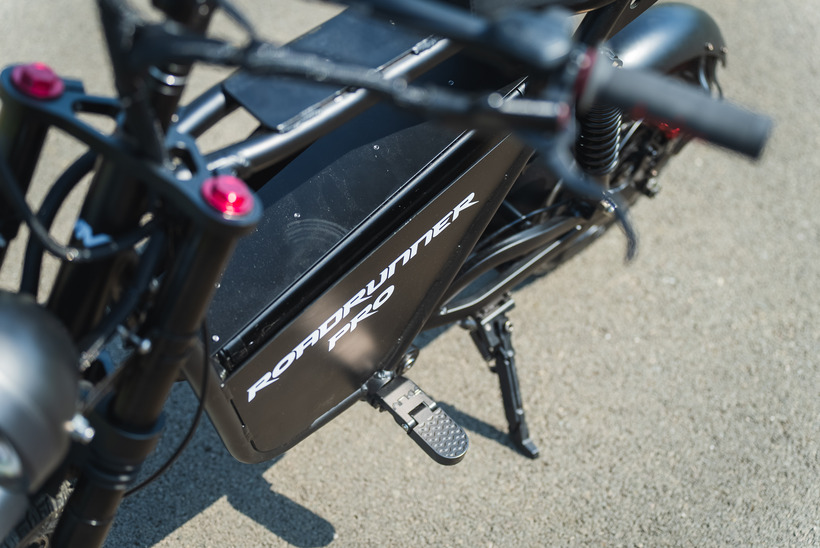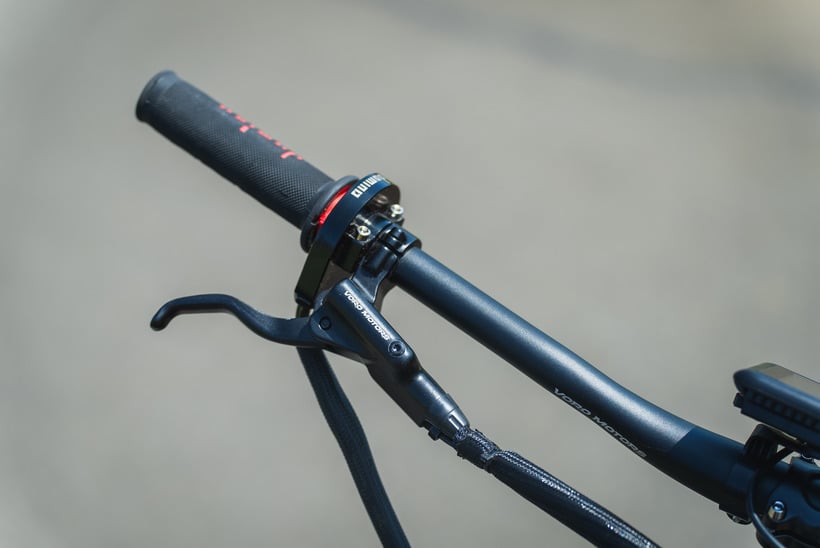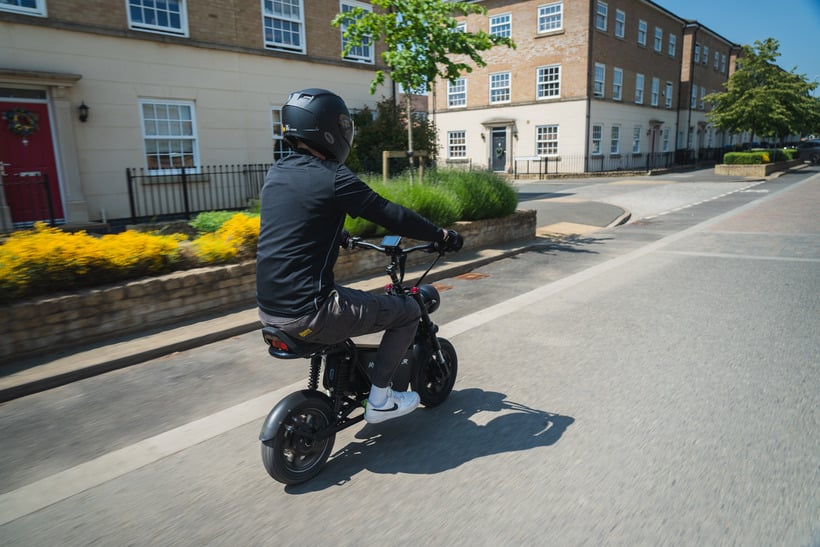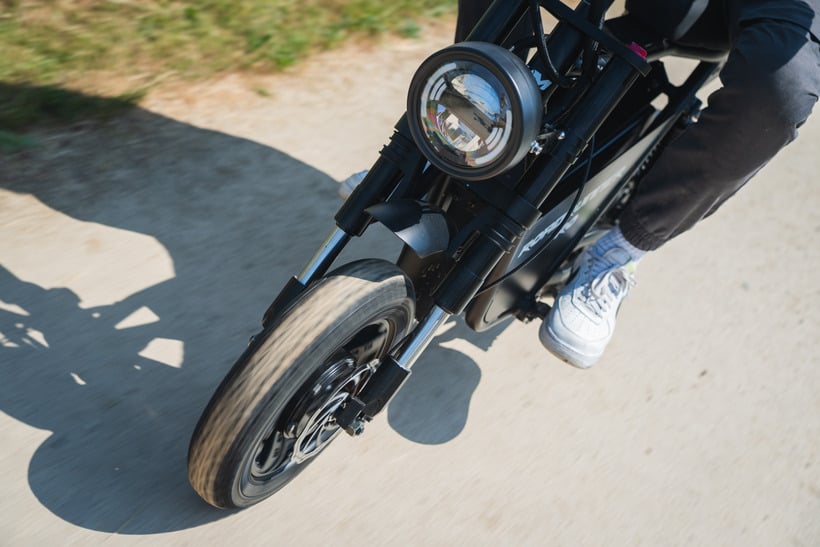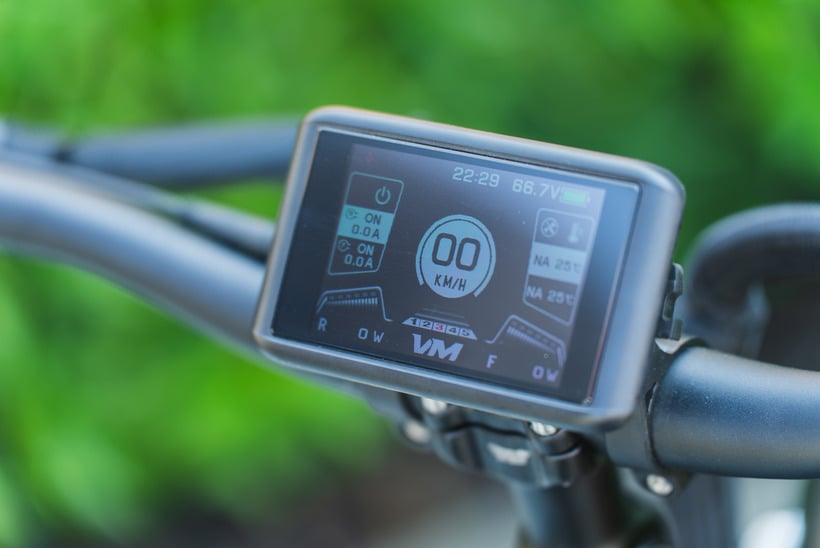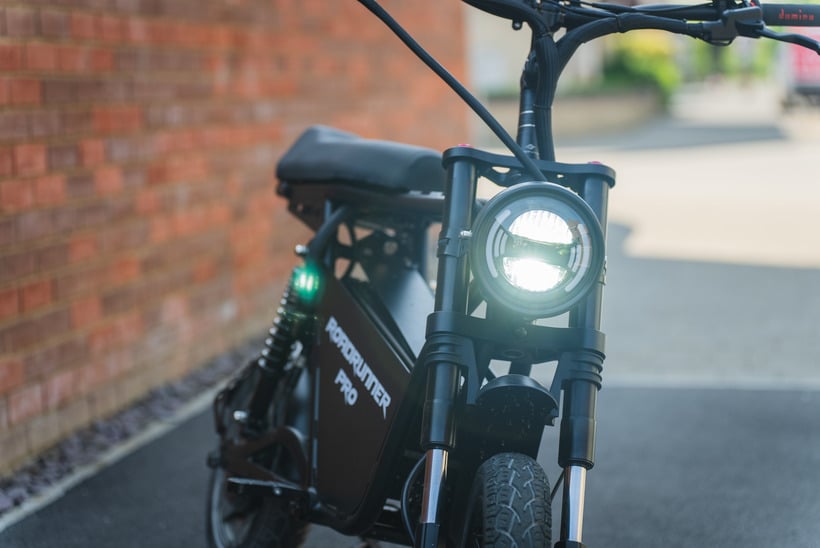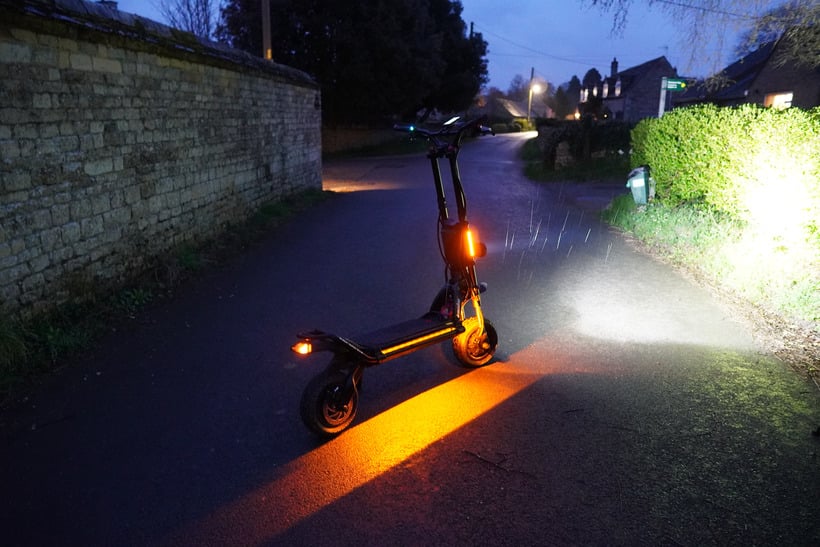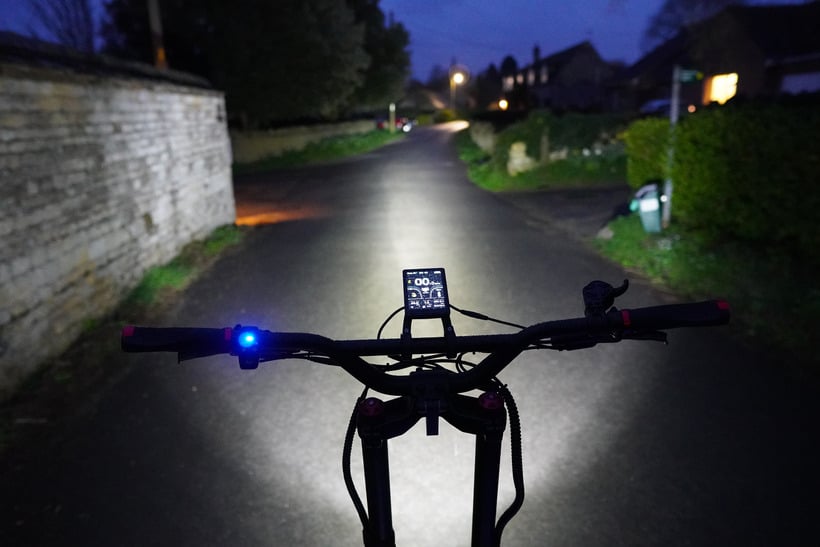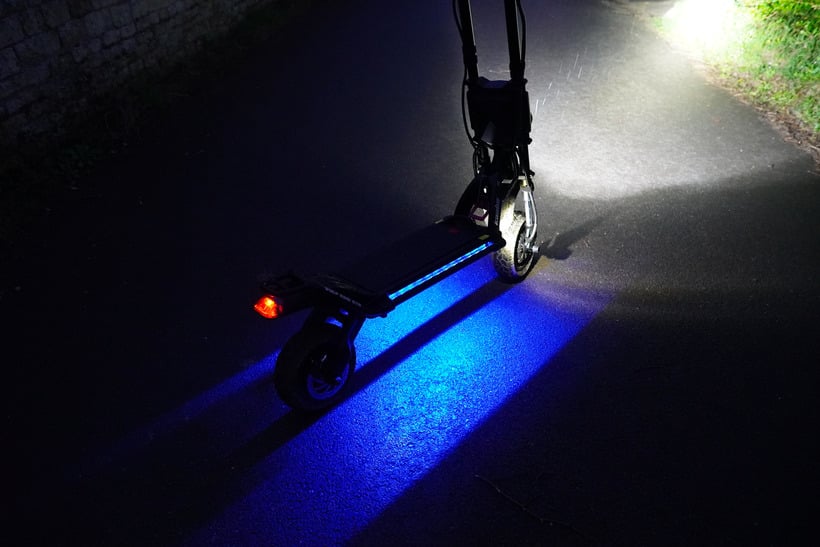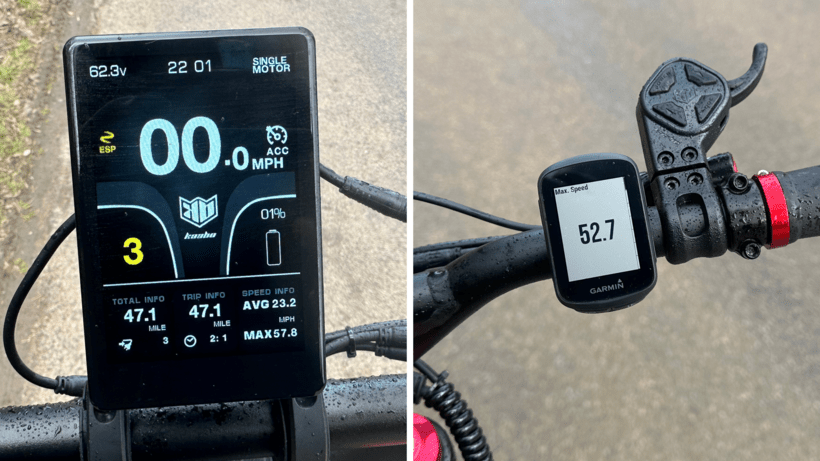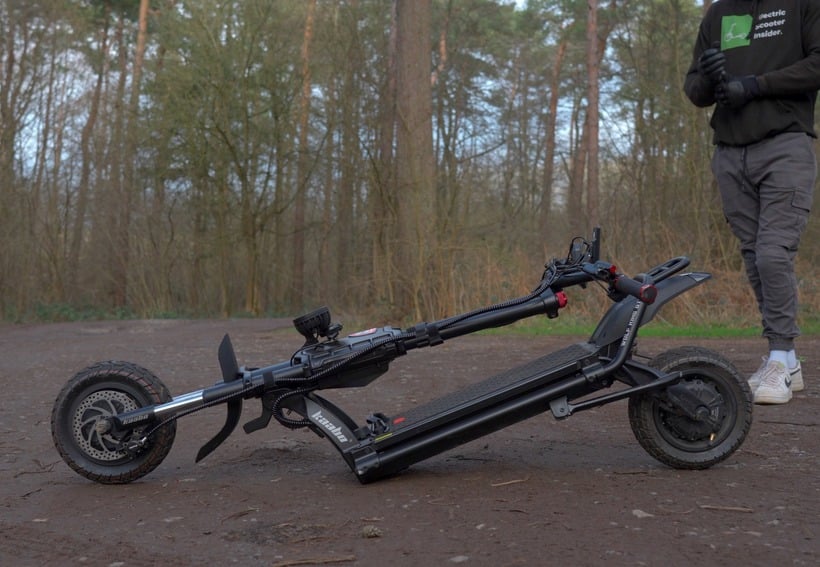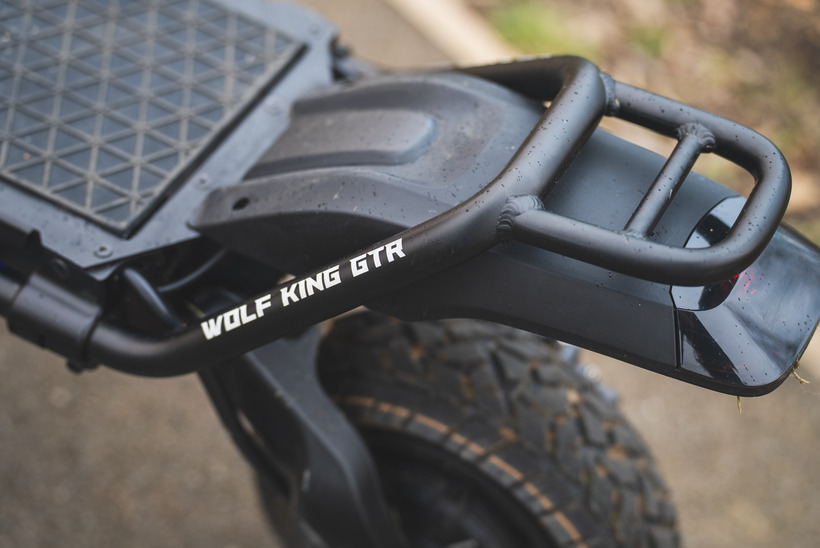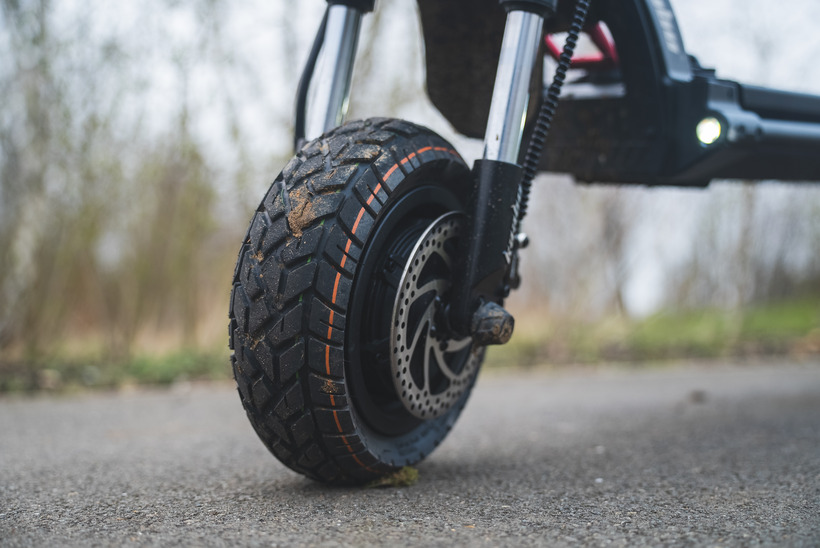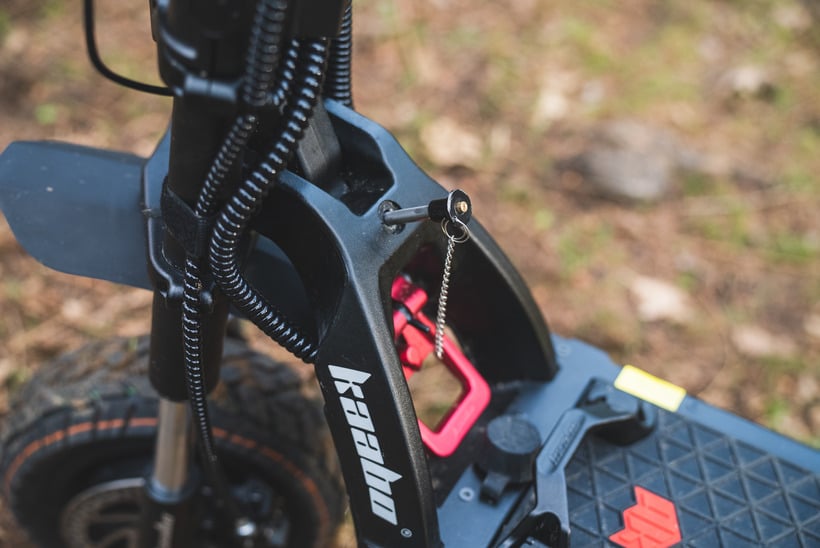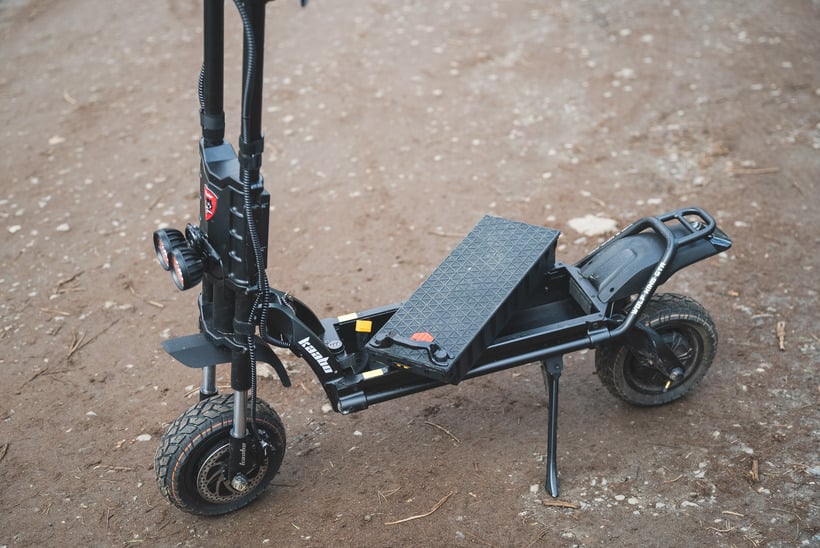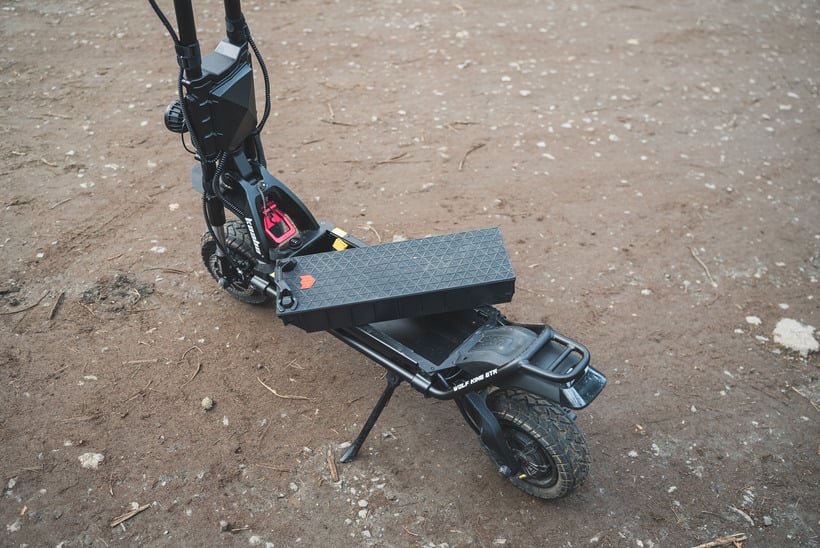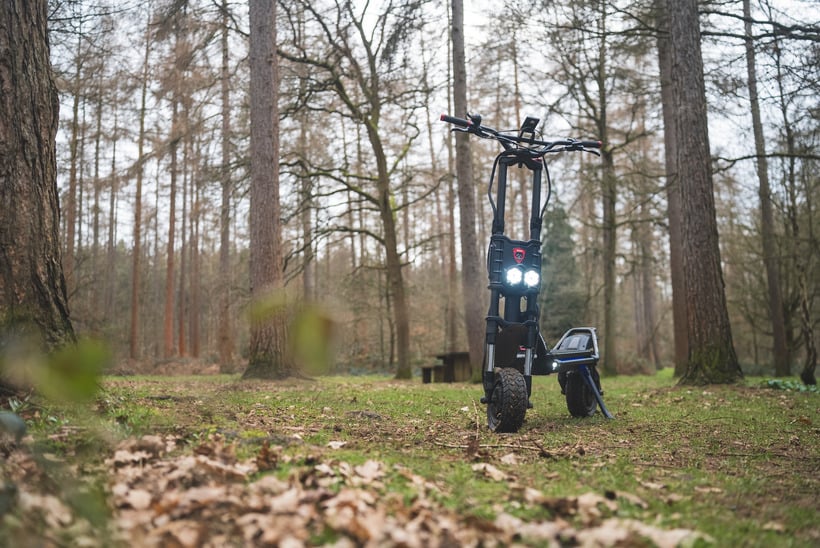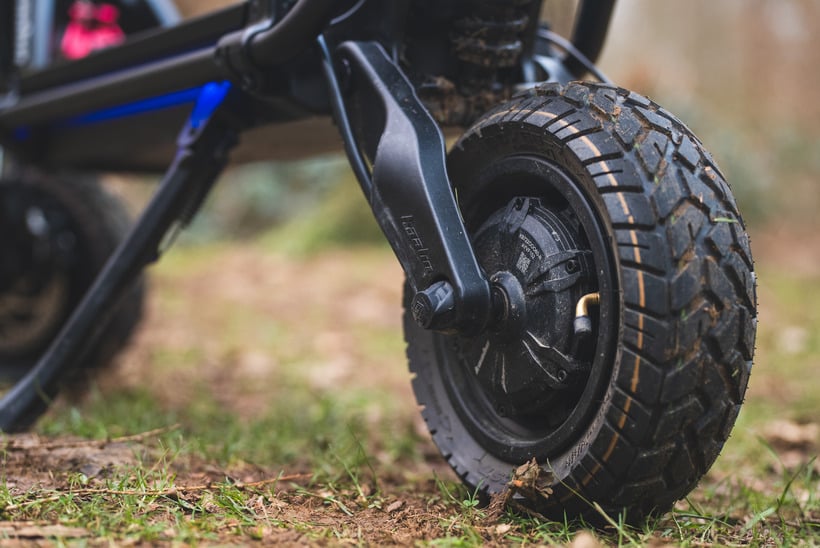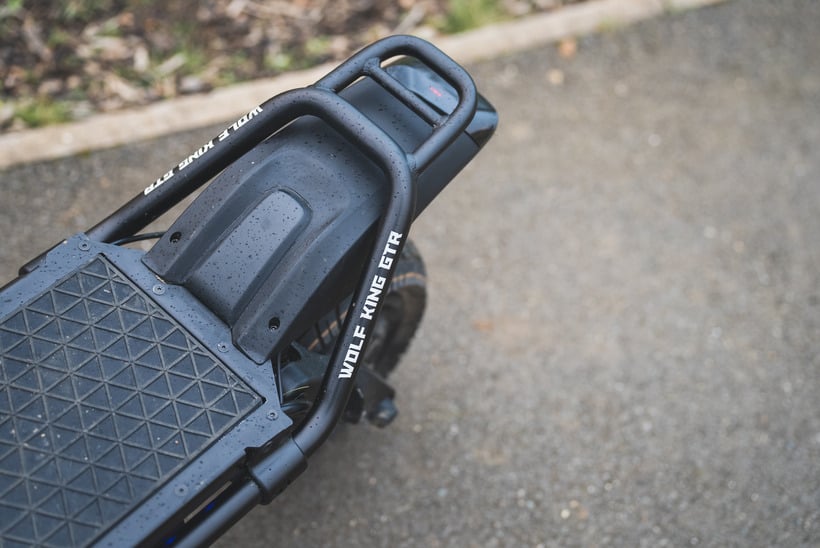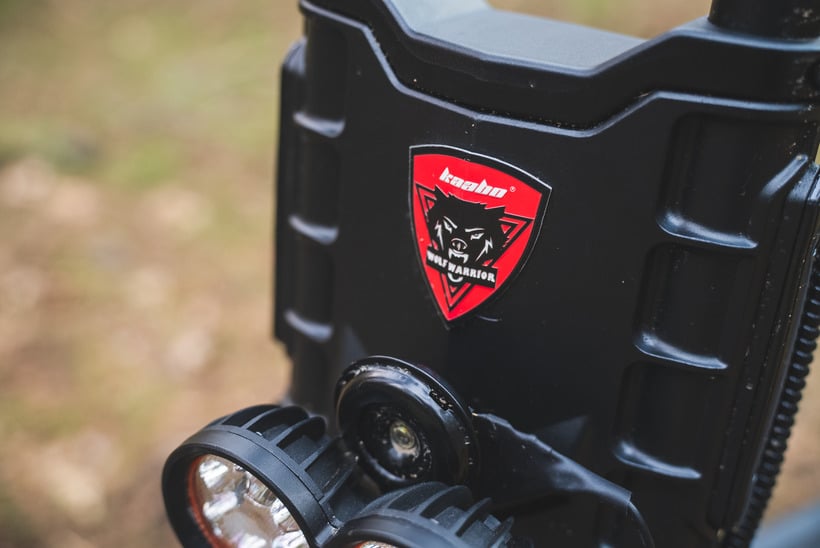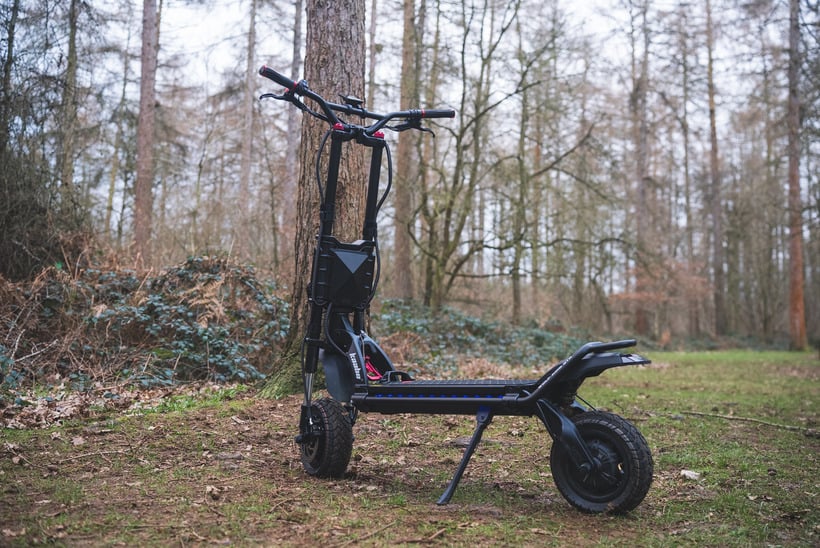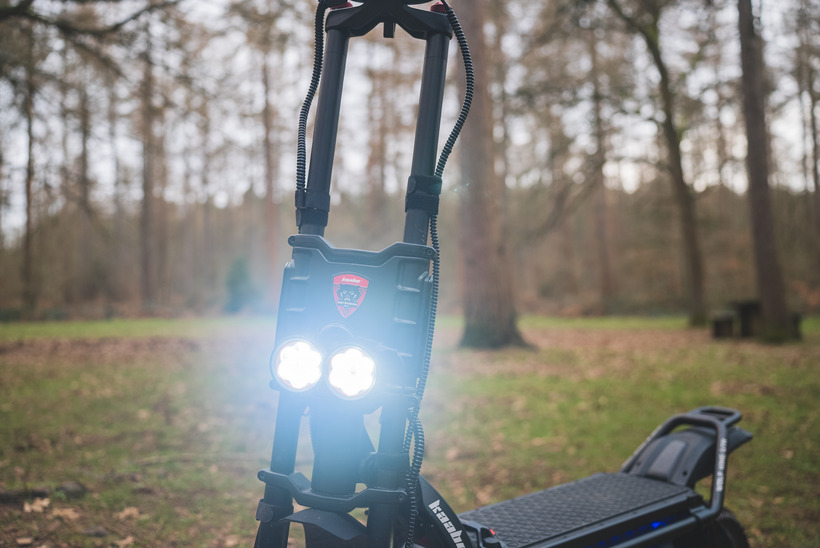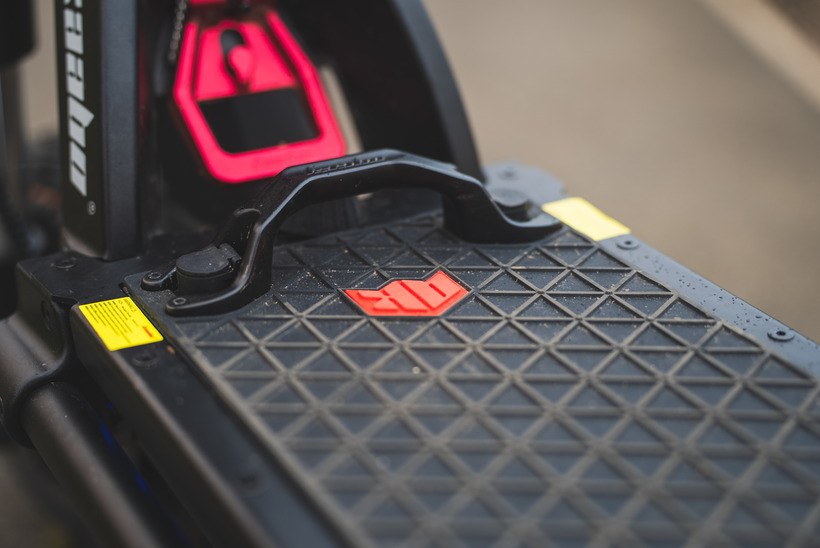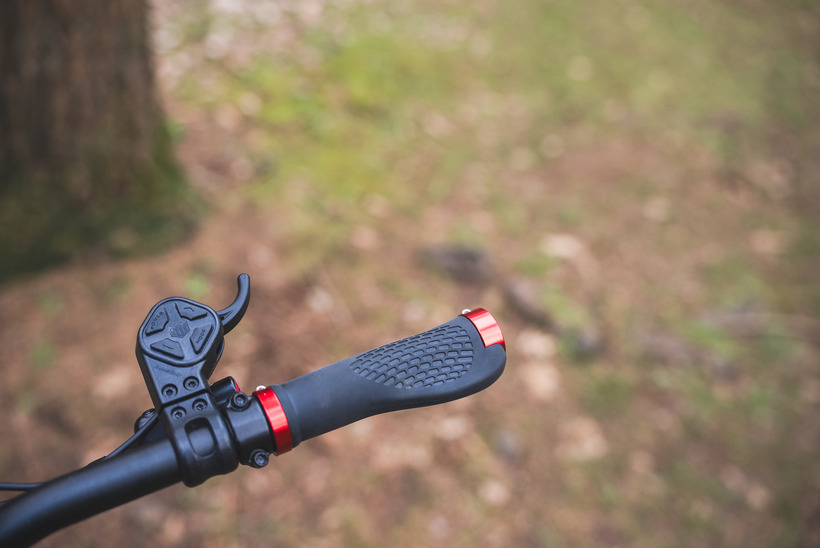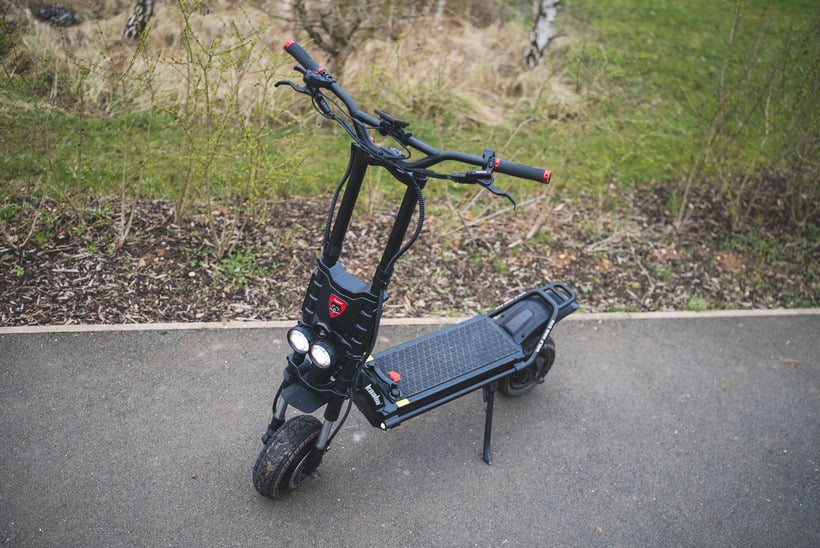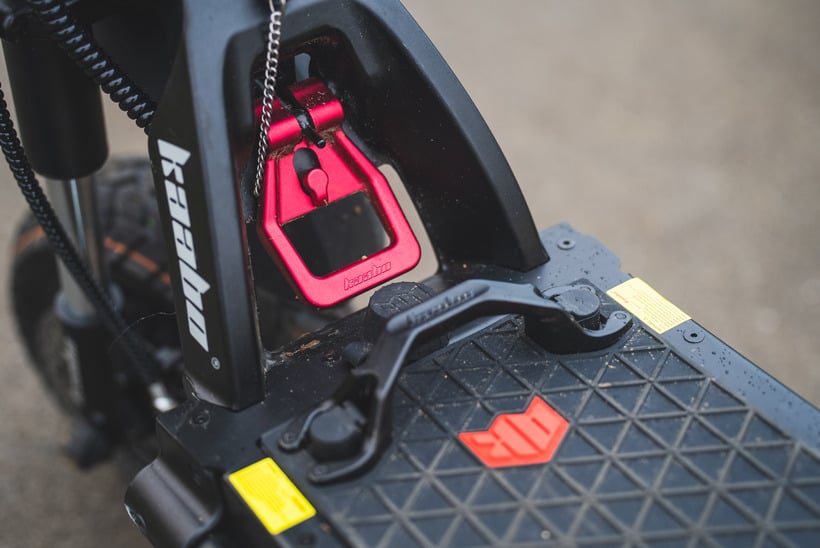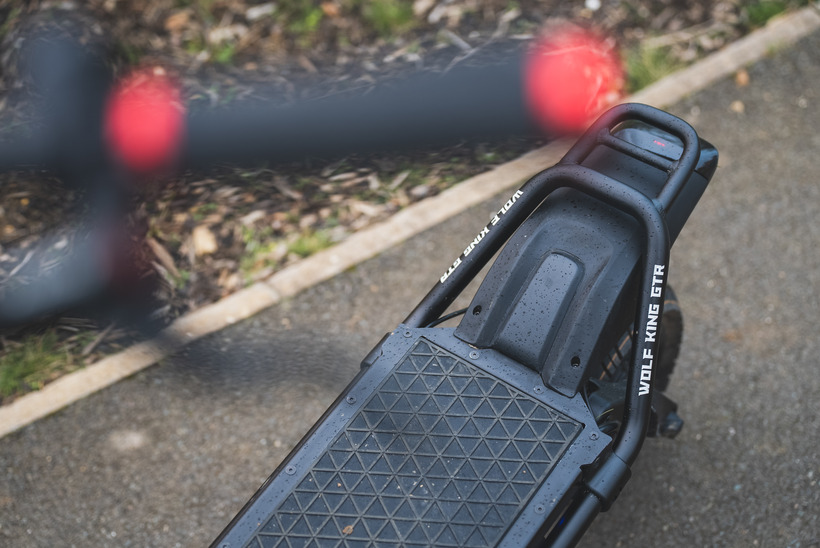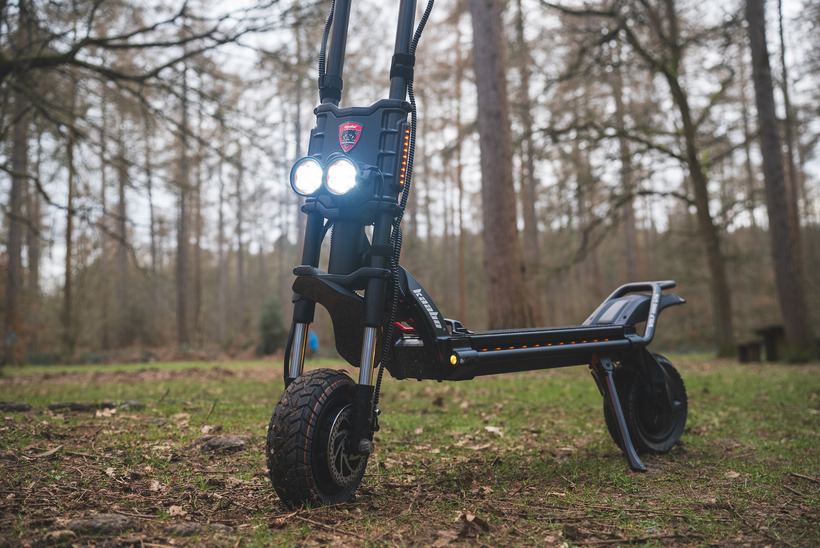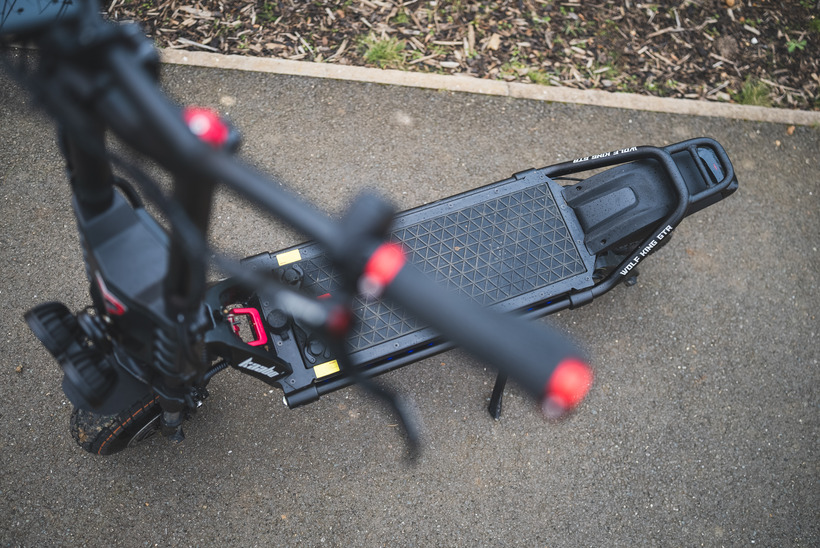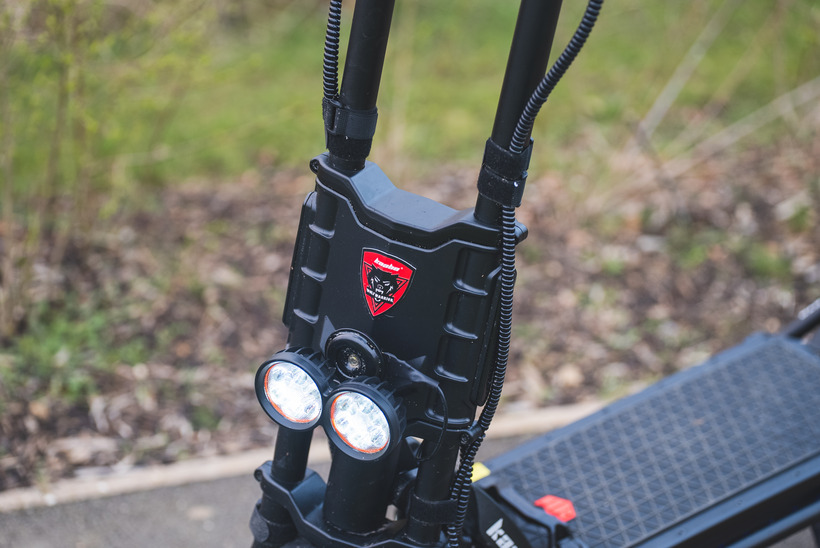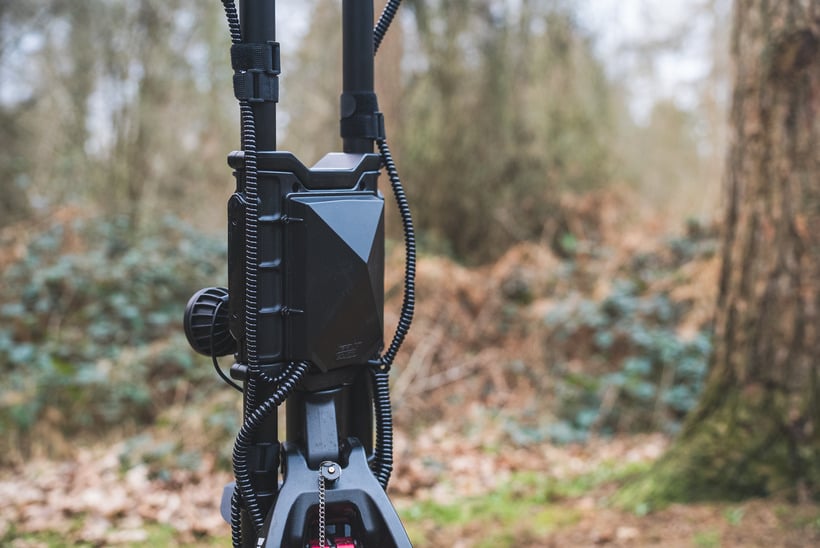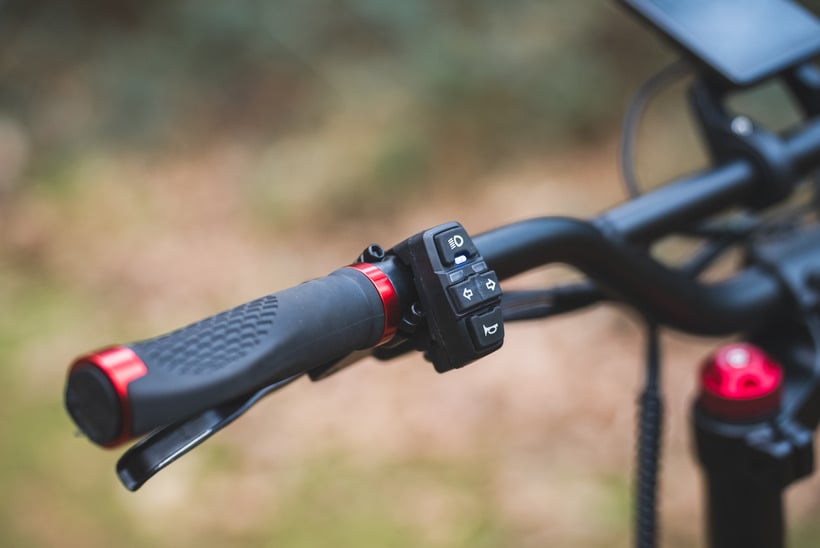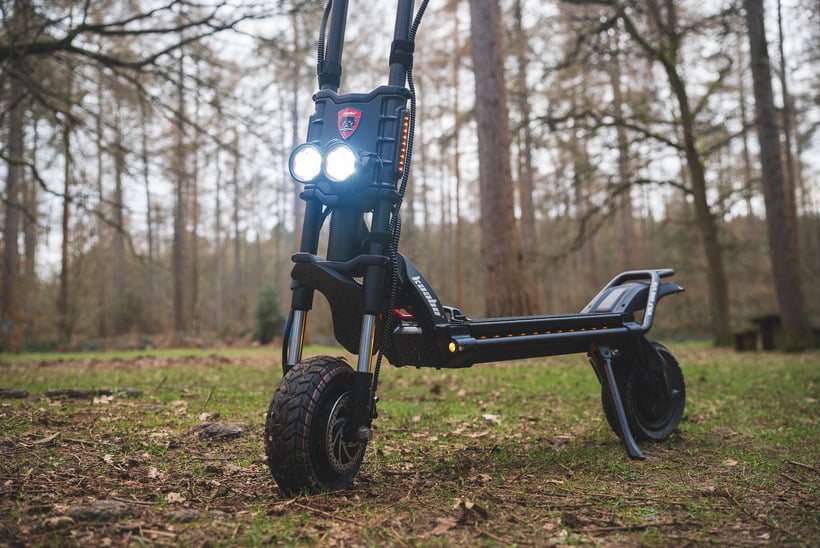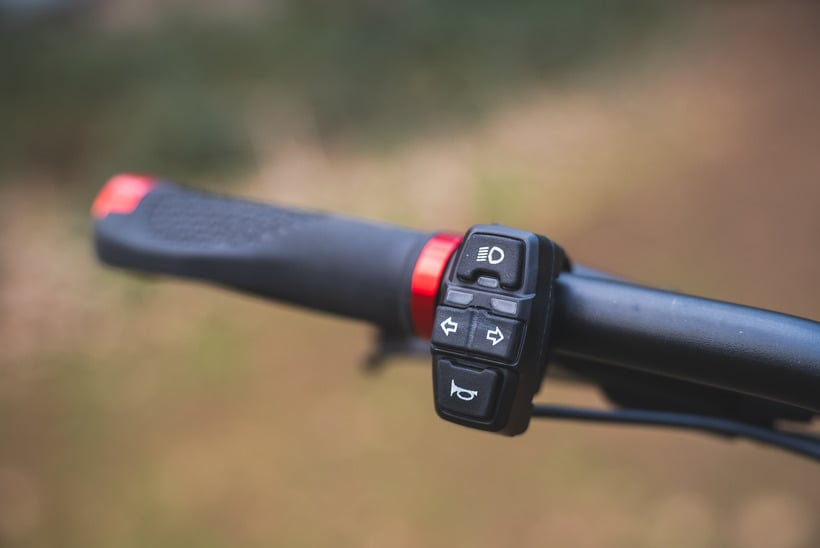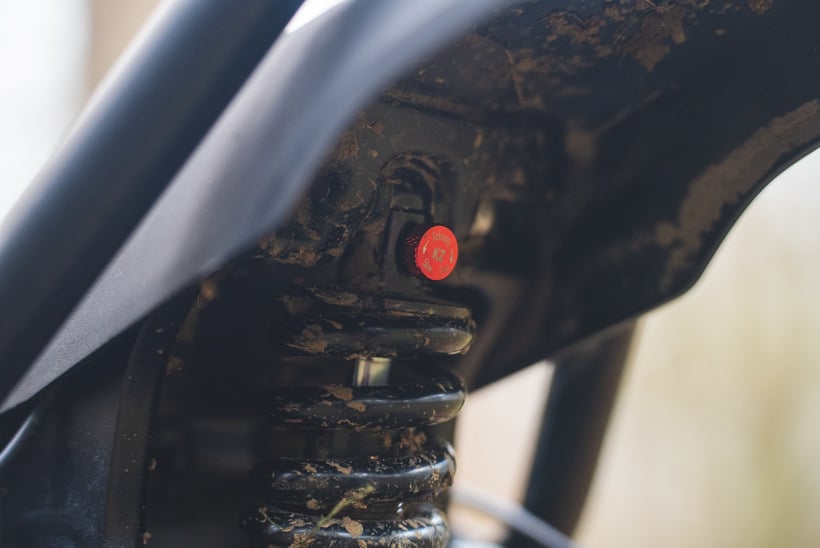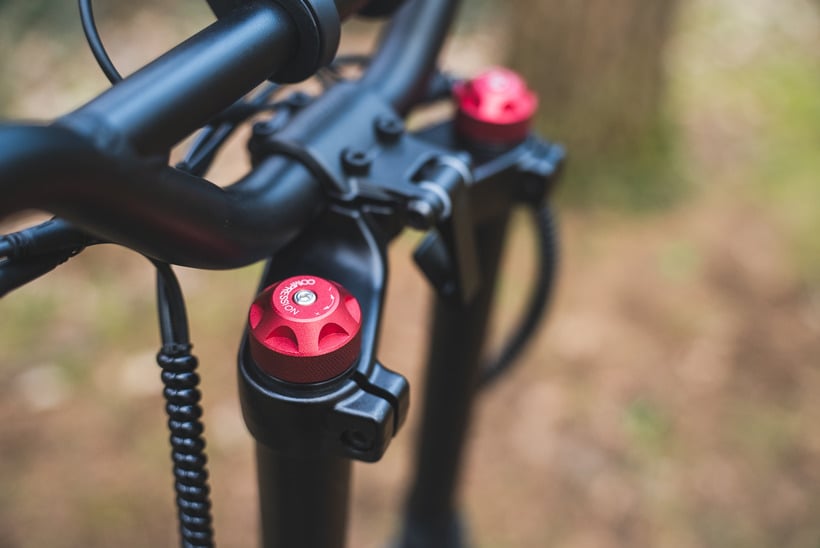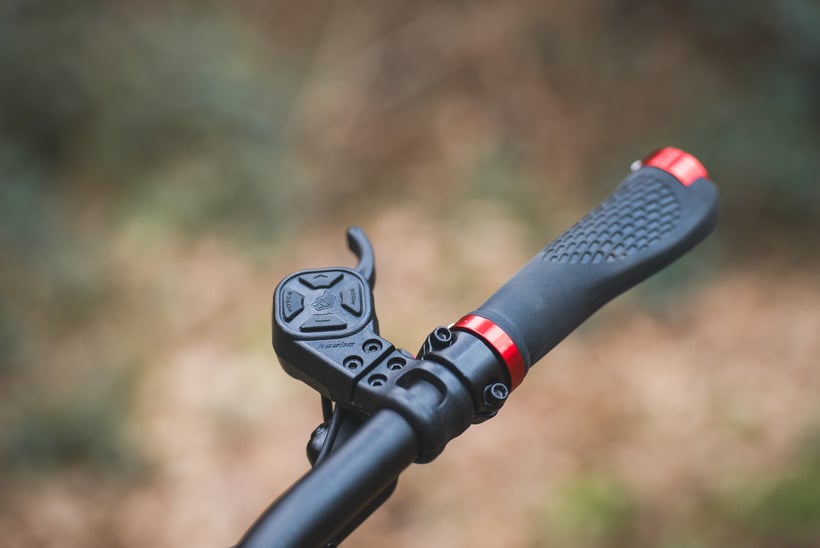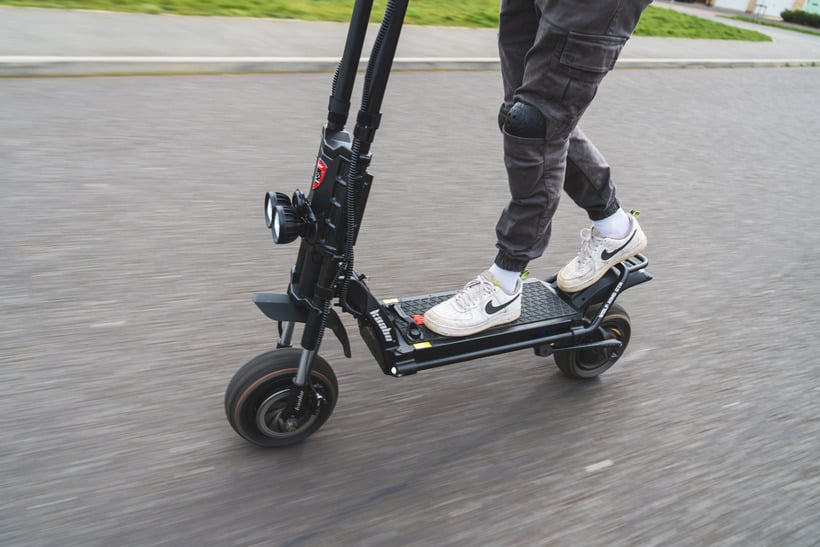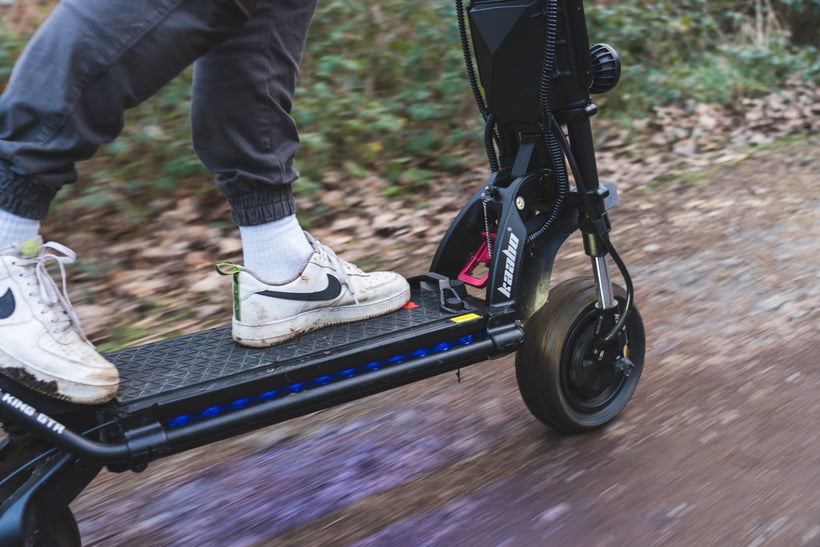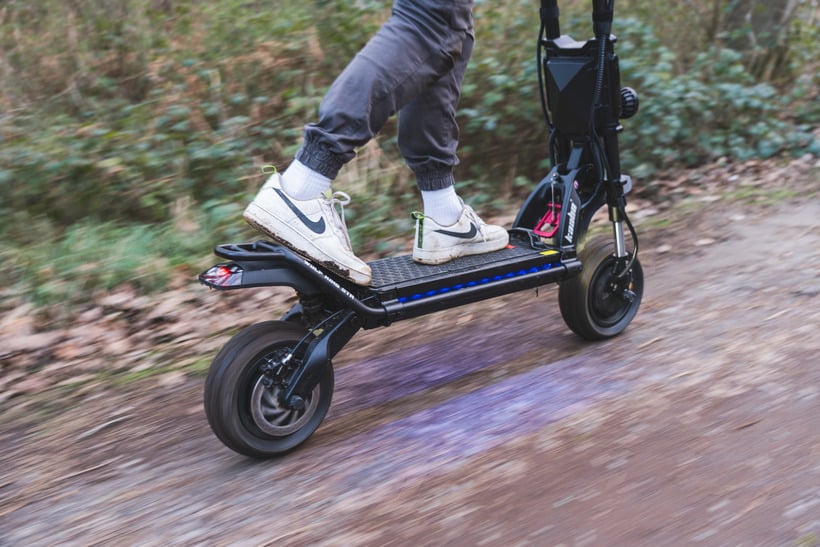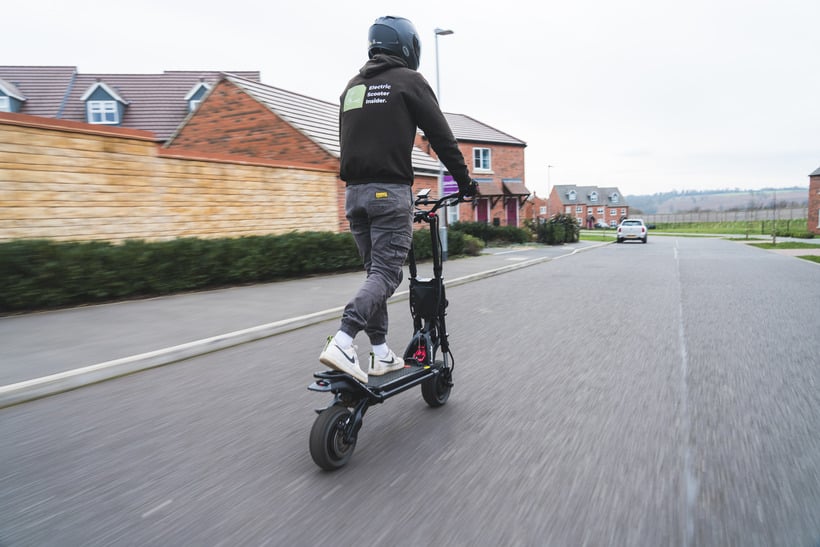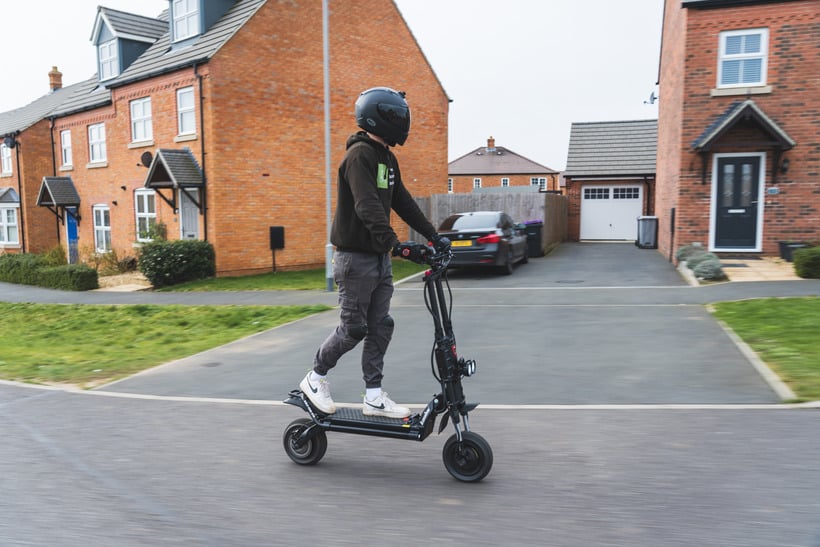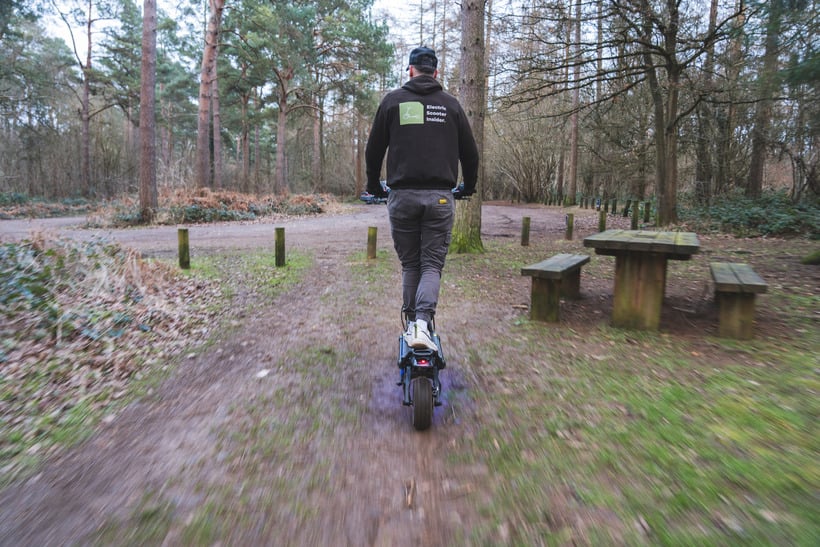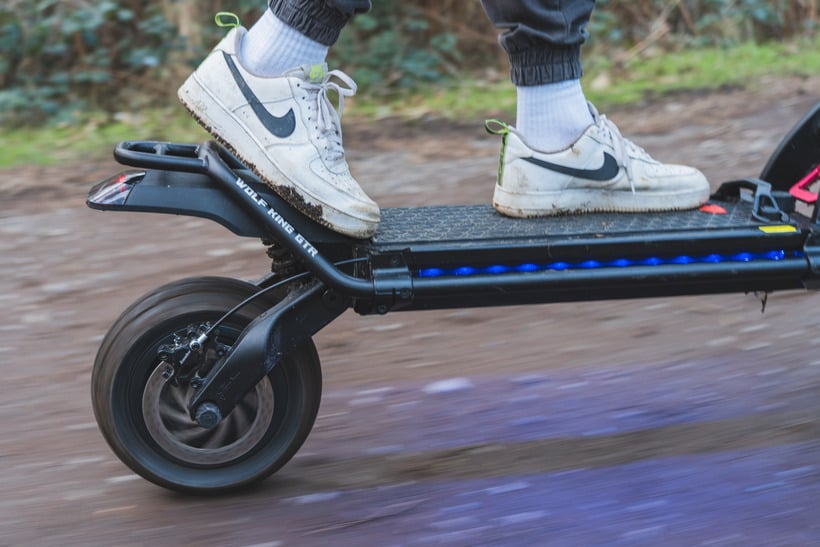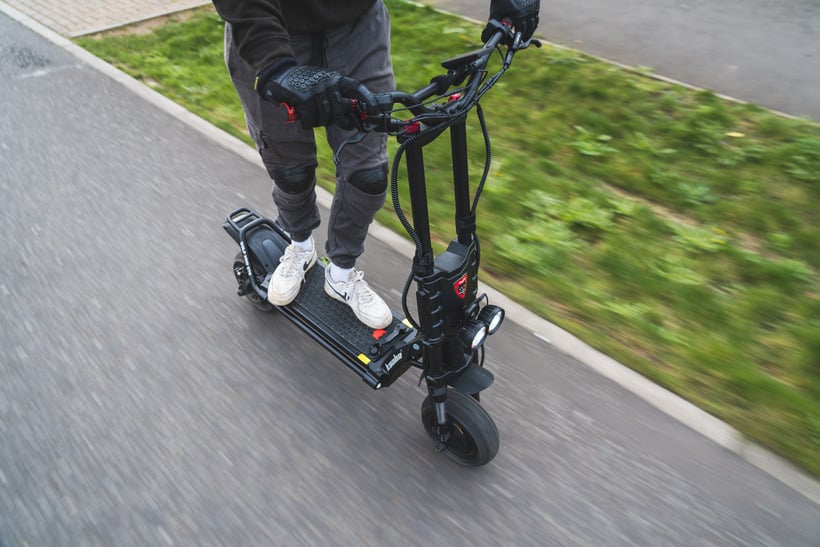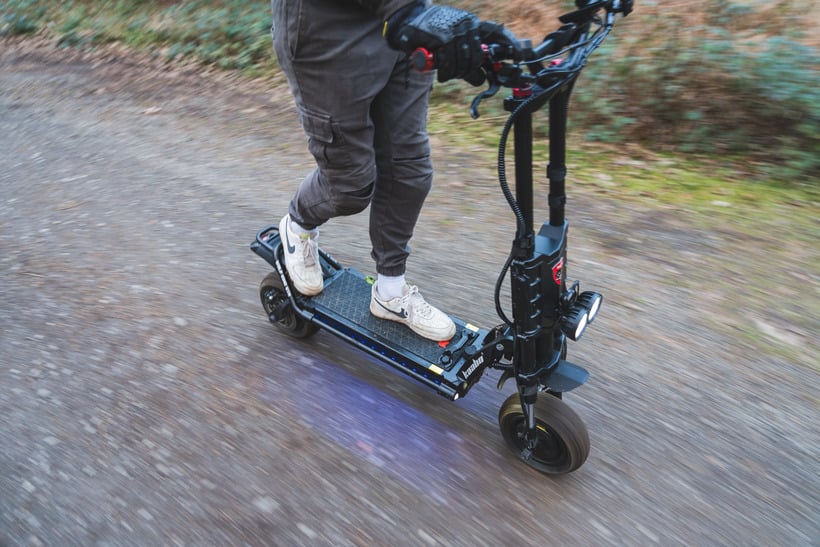Home » Best » Long-Range » Top Picks
Top Picks & Comparison: Long-Range Electric Scooters (Quick List)
Quick List: Best Long-Range Electric Scooters
I tested 47 electric scooters to find the 7 best long-range models.
- VMAX VX5 Pro GT – Best Budget
- VMAX VX2 Pro GT – Best Range Per Dollar
- VMAX VX4 GT – Best all-Arounder
- Mantis King GT – Best Off-Roader
- Apollo Pro – Best Tech Features
- EMOVE RoadRunner Pro – Best Seated
- Wolf King GTR – Fastest & Longest Range
Best Long-Range Electric Scooters
Best Budget

VMAX VX5 Pro GT
- Max Range: 22 miles
- Real Range: 19 miles
Performance Report
Performance Report:
Tester: Josh Frisby (197 lbs, 6.1 ft)
- Top Speed: 18 mph
- Real Speed: 17.4 mph*
- 0-15 mph: 6.7 s*
- Max Range: 22 miles
- Real Range: 19 miles*
- Braking: 2.0 meters*
- Suspension: n/a
- Max Incline: 14 degrees
- Optimal Incline: 8 degrees*
- Weight: 36.8 lbs
- Load: 265 lbs
Pros & Cons
The Good:
- Competitive performance profile
- 11% faster acceleration compared to the average of its rivals
- Shortest stopping distance among its rivals
- Best design and build in its price class
- Wider than normal handlebars promote good handling
- Regenerative braking system recycles kinetic energy to recharge the battery on the go
- High quality UL2272-certified battery
- Grippy and nimble 8.5-inch tubed tires
- Immaculate cable management
- Mobile app allows for customized performance
- Slick folding mechanism
- 40.2-inch deck-to-handlebar height makes it suitable for tall riders up to 6’3”
- Protective IPX6 water-resistance rating
- Long fenders that prevent splashback
- Quiet motor
- Low maintenance
- 2-year warranty
The Bad:
- Display gets washed out in direct light
- The taillight is bright at night, but it doesn’t flash when you brake - it just glows a brighter red
Video Review
Best Range Per Dollar

VMAX VX2 Pro GT
- Max Range: 37 miles
- Real Range: 30.6 miles
Performance Report
Performance Report:
Tester: Josh Frisby (190 lbs, 6.1 ft)
- Top Speed: 24 mph
- Real Speed: 24.5 mph*
- 0-15 mph: 3.8 s*
- Max Range: 37 miles
- Real Range: 30.6 miles*
- Braking: 3.0 meters*
- Suspension: n/a
- Max Incline: 15 degrees
- Optimal Incline: 9 degrees*
- Weight: 45 lbs
- Load: 287 lbs
Pros & Cons
The Good:
- Longest tested range in the sub-$1,000 class
- Fastest acceleration among similarly priced single-motor scooters
- Strong brakes that use a regenerative system to recycle kinetic energy to recharge the battery on the go
- Exceptionally quiet motor
- Impeccable build quality
- Nimble tubeless tires
- Suitable for tall and heavy riders
- Bright lights with excellent turn signals that are visible from the front, rear, and sides
- Mobile app allows for customized performance
- Slick folding mechanism
- Tidy cable management
- Protective IPX6 water-resistance rating
- Long fenders that prevent splashback
- Low maintenance
- 2-year warranty
The Bad:
- Doesn’t have suspension
- Display gets washed out in direct light
- The taillight is bright at night, but it doesn’t flash when you brake - it just glows a brighter red
Video Review
Best All-Rounder

VMAX VX4 GT
- Max Range: 62 miles
- Real Range: 36.7 miles
Performance Report
Performance Report:
Tester: Josh Frisby (197 lbs, 6.1 ft)
- Top Speed: 25 mph
- Real Speed: 25.8 mph*
- 0-15 mph: 3.2 s*
- 0-25 mph: 9.6 s*
- Max Range: 62 miles
- Real Range: 36.7 miles*
- Braking: 3.4 meters*
- Suspension: 6.5/10*
- Max Incline: 18 degrees
- Optimal Incline: 11 degrees*
- Weight: 63.9 lbs
- Load: 330 lbs
Pros & Cons
The Good:
- Long real-world tested range
- Zippy acceleration
- Quiet motor
- Smooth front and rear suspension
- Versatile hybrid tubeless tires
- Great handling
- Excellent build quality
- Regenerative braking system that recycles kinetic energy to recharge the battery on the go
- Immaculate cable management
- Spacious dimensions
- Suitable for tall and heavy riders (up to 6’4” and 330 lbs)
- Bright turn signals ensure 360-degree visibility
- Display remains visible under direct sunlight
- Long fenders prevent splashback
- Protective IPX6 water-resistance rating
- Low maintenance
- 2-year warranty
The Bad:
- While the folding lever is simple to operate, the same can’t be said for how the latch on the back of the handlebars hooks to the kickplate. It’s difficult to connect the two, and they have a habit of becoming unhooked. This makes the scooter cumbersome to maneuver when folded
- Installing the handlebars is fiddly - there was a lot of extra slack in the thick wires and a very narrow hole to stick them through
- The button pad to control the settings, turn signals, and riding modes is well positioned but would benefit from a more responsive design - with gloves on it was hard to tell if I had pressed the turn signal or riding mode button
- The taillight is bright at night, but it doesn’t flash when you brake - it just glows a brighter red
Video Review
Best Off-Roader

Mantis King GT
- Max Range: 56 miles
- Real Range: 38 miles
Performance Report
Performance Report:
Tester: Josh Frisby (190 lbs, 6.1 ft)
- Top Speed: 43 mph
- Real Speed: 45 mph*
- 0-15 mph: 1.9 s*
- 0-25 mph: 4.0 s*
- 0-30 mph: 5.7 s*
- 0-35 mph: 7.8 s*
- Max Range: 56 miles
- Real Range: 38 miles*
- Braking: 2.1 meters*
- Suspension: 9/10*
- Max Incline: 30 degrees
- Optimal Incline: 18 degrees*
- Weight: 79 lbs
- Load: 265 lbs
Pros & Cons
The Good:
- Best-in-class performance
- Industry-leading design
- Exceptional build and ride quality
- 30A Sine Wave controllers deliver a smooth, fast acceleration
- High-quality Samsung battery
- Adjustable hydraulic suspension
- Terrain-agnostic tires
- Advanced TFT display
- Controllable LED lights
- Superb folding mechanism
- Wide handlebars and ergonomic controls afford excellent control
- Powerful hydraulic brakes
- IPX5 water-resistance rating
The Bad:
- Headlight could be brighter
Video Review
Best Tech Features
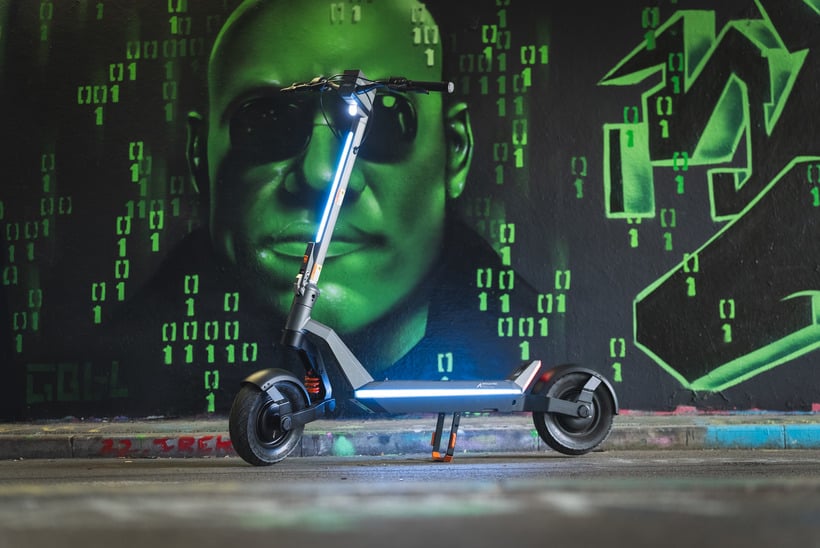
Apollo Pro
- Max Range: 63 miles
- Real Range: 39 miles
Performance Report
Performance Report:
Tester: Josh Frisby (190 lbs, 6.1 ft)
- Top Speed: 44 mph
- Real Speed: 44 mph*
- 0-15 mph: 2.1 s*
- 0-25 mph: 4.3 s*
- 0-30 mph: 6.3 s*
- 0-35 mph: 9.3 s*
- Max Range: 63 miles
- Real Range: 39 miles*
- Braking: 2.3 meters*
- Suspension: 7/10*
- Max Incline: 30 degrees
- Optimal Incline: 18 degrees*
- Weight: 93 lbs
- Load: 330 lbs
Pros & Cons
The Good:
- Red Dot Design Award winner
- Industry-leading build quality
- Looks like a Tesla Cybertruck
- Futuristic 360-degree dynamic lighting rig
- Competitive speed, acceleration, range, and braking performance
- AG geometry promises intuitive control and best-in-class handling
- Integrated IoT gives you access to 24/7 GPS tracking so you can flag your scooter lost or stolen and activate its kill switch
- Regen brakes recharge your battery up to 10%
- DOT Matrix display is extremely bright and easy to read from any angle
- QuadLock phone mount supports wireless charging and allows you to use the app on your phone as the primary display
- Mobile app lets you customize performance settings
- Built-in Bluetooth speaker
- 12-inch self-healing tires
- Well suited to tall and heavy riders
- Low-maintenance
- IP66 water-resistance rating
The Bad:
- Some scooters within its price class go faster and further. But, none can compete with the Pro’s integration of tech, unique features, and reliable, low-maintenance build
- Suspension system could be more plush
Video Review
Best Seated

EMOVE RoadRunner Pro
- Max Range: 50 miles
- Real Range: 34 miles
Performance Report
Performance Report:
Tester: Josh Frisby (190 lbs, 6.1 ft)
- Top Speed: 50 mph
- Real Speed: 54 mph*
- 0-15 mph: 2.6 s*
- 0-25 mph: 4.3 s*
- 0-30 mph: 5.9 s*
- Max Range: 50 miles
- Real Range: 34 miles*
- Braking: 3.0 meters*
- Suspension: 8/10*
- Max Incline: 30 degrees
- Optimal Incline: 18 degrees*
- Weight: 114 lbs
- Load: 330 lbs
Pros & Cons
The Good:
- Most powerful seated electric scooter
- Plush memory foam seat that's 3.5 inches thick
- Long saddle ensures that you can find a comfortable riding position
- The seat's outer fabric is both wear and heat-resistant
- Ultra-wide handlebars adjust high, low, towards, and away from you
- Motorcycle-grade ride quality
- Addictive to cruise and corner on
- Twist-grip throttle
- Supremely comfortable seat
- Premium LG battery cells are long-lasting
- Removable battery enables a limitless range and easier charging
- Great value for money
- Feature-rich color display
- Exceptionally bright headlight
- Huge 14-inch tubeless tires offer stability and shock absorption
- Supports heavy riders
- Strong hydraulic brakes
- Plush suspension system
The Bad:
- No water-resistance rating
- The chassis that houses the battery could be better designed
- It’s difficult to see which riding mode you’re in
- You need to be mindful of how heavy you are on the throttle to prevent excessive wheel spin
Video Review
Fastest & Longest Range

Wolf King GTR
- Max Range: 112 miles
- Real Range: 42.8 miles
Performance Report
Performance Report:
Tester: Josh Frisby (197 lbs, 6.1 ft)
- Top Speed: 65 mph
- Real Speed: 65.8 mph**
- 0-15 mph: 1.6 s*
- 0-25 mph: 2.8 s*
- 0-30 mph: 3.4 s*
- 0-35 mph: 4.2 s*
- 0-40 mph: 5.2 s*
- Max Range: 112 miles
- Real Range: 42.8 miles*
- Braking: 3.0 meters*
- Suspension: 8.5/10*
- Max Incline: 50 degrees
- Optimal Incline: 30 degrees*
- Weight: 137 lbs
- Load: 330 lbs
*Based on my tests and assessments
**Based on third-party tests
Pros & Cons
The Good:
- Fastest scooter on the market
- Acceleration is the quickest that I’ve ever tested
- Powerful 2-in-1 100A Sine Wave controller (peaks at 160A)
- Has traction control
- A well-balanced frame, reliable dual stem, and ultra-wide handlebars make it extremely stable when ripping top speeds
- Zoom hydraulic brake calipers and thick rotors ensure responsive stopping power
- Shock absorption of the GTR is far better than the original GT thanks to the new adjustable hydraulic shocks
- Versatile self-healing tires
- Long real-world range
- Removable battery makes charging easy
- Best hill climber that I’ve tested
- Huge deck and extended kickplate allow for plenty of room
- The most ground clearance of any scooter
- Ideal for heavy riders
- Bright and easy-to-read TFT display
- Super bright dual headlights and deck-embedded LEDs
- Turn signals are visible from all angles
- IPX5 water resistance rating
The Bad:
- Extremely heavy
- The folding mechanism is clunky and the most difficult to use out of all of the scooters that I’ve tested
- While the removable battery is a useful feature, the connector is a little difficult to attach and detach due to a lack of space
- The smoked taillight is hard to see in daylight, and it doesn't flash when you brake (instead, it glows brighter)
Video Review
Compare Long-Range Electric Scooters
VMAX VX5 Pro | VMAX VX2 Pro | VMAX VX4 | Mantis King GT | Apollo Pro | RoadRunner Pro | Wolf King GTR |
|
|---|---|---|---|---|---|---|---|
| Where to Buy | VMAX | VMAX | VMAX | Kaabo | Apollo | Voro | Kaabo |
| Price | $499 | $899 | $1,299 | $1,899 | $2,449 | $2,695 | $3,499 |
| Category | Best Budget | Best Range Per Dollar | Best All-Rounder | Best Off-Roader | Best Tech Features | Best Seated | Fastest & Longest Range |
| Review | Review | Review | Review | Review | Review | Review | Review |
| Performance | |||||||
| Top Speed | 18 mph | 24 mph | 25 mph | 43 mph | 44 mph | 50 mph | 65 mph |
| 0-15 MPH | 6.7 s | 3.8 s | 3.2 s | 1.9 s | 2.1 s | 2.6 s | 1.6 s |
| 0-25 MPH | n/a | n/a | 9.6 s | 4.0 s | 4.3 s | 4.3 s | 2.8 s |
| Max Range | 22 miles | 37 miles | 62 miles | 56 miles | 63 miles | 50 miles | 112 miles |
| Tested Range | 19 miles | 30.6 miles | 36.7 miles | 38 miles | 39 miles | 34 miles | 42.8 miles |
| Braking | 2.0 meters | 3.0 meters | 3.4 meters | 2.1 meters | 2.3 meters | 3.0 meters | 3.0 meters |
| Shock Absorp. | n/a | n/a | 6.5/10 | 9/10 | 7/10 | 8/10 | 8.5/10 |
| Max Incline | 14 degrees | 15 degrees | 18 degrees | 30 degrees | 30 degrees | 30 degrees | 50 degrees |
| Optimal Incline | 8 degrees | 9 degrees | 11 degrees | 18 degrees | 18 degrees | 18 degrees | 30 degrees |
| Specs | |||||||
| Motor | 36V 400W | 48V 500W | 48V 500W | 60V 1100W (x2) | 52V 1200W (x2) | 60V 2000W (x2) | 72V 2000W (x2) |
| Throttle | Thumb | Thumb | Thumb | Thumb | Thumb | Twist | Finger |
| Battery | 36V 10.4Ah FST | 48V 16Ah FST | 48V 23.2Ah FST | 60V 24Ah Samsung | 52V 30Ah Samsung | 60V 30Ah LG | 72V 35Ah LG |
| Charge Time | 5 hours | 8.5 hours | 12 hours | 6 hours | 6 hours | 10 hours | 12 hours |
| Brakes | Drum, Regen | Drum, Regen | Drum, Regen | Hydraulic Discs (x2), Electronic | Drums (x2), Regen | Hydraulic Discs (x2), Electronic | Hydraulic Discs (x2), Electronic |
| Suspension | None | None | Hydraulic Fork, Rubber Block, Swingarms | Adjust. Hydraulic Springs, Swingarms | Adjust. Hydraulic Spring, Rubber Cartridge | Hydraulic Forks, Springs | Adjust. Hydraulic Fork, Adjust. Hydraulic Spring, Swingarms |
| Tire Size | 9 inch | 10 inch | 10 inch | 10 inch | 12 inch | 14 inch | 12 inch |
| Tire Type | Air (Tubeless) | Air (Tubeless) | Air (Tubeless) | Air (Inner-Tube) | Air (Tubeless, Self-Healing) | Air (Tubeless) | Air (Tubeless, Self-Healing) |
| Weight | 36.8 lbs | 45 lbs | 63.9 lbs | 79 lbs | 93 lbs | 114 lbs | 137 lbs |
| Load | 265 lbs | 287 lbs | 330 lbs | 265 lbs | 330 lbs | 330 lbs | 330 lbs |
| Foldability | Folds at Stem | Folds at Stem | Folds at Stem | Folds at Stem | Folds at Neck | N/A | Folds at Neck |
| IP Rating | IPX6 | IPX6 | IPX6 | IPX5 | IP66 | None | IPX5 |
| Lights | Headlight, Taillight, Turn Signals | Headlight, Taillight, Turn Signals | Headlight, Taillight, Turn Signals | Headlight, Taillight, Deck, Customizable RGB, Turn Signals | Headlight, Stem, Deck, Taillight, Turn Signals | Headlight, Taillight, Turn Signals | Dual Headlights, Taillight, Deck, Turn Signals |
| Terrain | Street | Street | Street, Off-Road | Street, Off-Road | Street | Street | Street, Off-Road |
How Did I Test the Scooters?
Test Criteria
To find the 7 best long-range electric scooters, I tested 47 models. Each was evaluated on its maximum and real-world range, ride quality, reliability, charge time, battery capacity, battery quality, and the performance of its battery management system.
Maximum & Real-World Range
These are the headline stats that most riders will notice when looking for a long-range electric scooter.
A model’s maximum range, as indicated by the manufacturer, refers to its mileage when ridden under best-case conditions. Typically, this includes a 165 lb rider, flat terrain, and riding in the slowest setting. While these figures are useful for comparing performance, they don’t paint the full picture.

As a result, I reported on how each scooter performed under real-world conditions – including me as a 190-197 lb rider, periods of fast acceleration, cruising, and multiple stops. This data was then used to assess range relative to price to identify the top performers for different budgets.
Based on my tests, as well as third-party data, the real-world range typically equates to 60% of the maximum.
Battery Size
Electric scooters with the longest range in each price category invariably have the largest batteries relative to their peers. To determine the size of each scooter’s unit, I reported on their voltage (V), amp-hours (Ah), and watt-hours (Wh).
The voltage of a battery refers to the strength of its electrical charge. Amp-hours, meanwhile, indicate how much electricity can be supplied from the battery to other electrical components (like the motors) in an hour. And finally, watt-hours are used to measure battery capacity – it’s calculated by multiplying voltage by amp-hours.
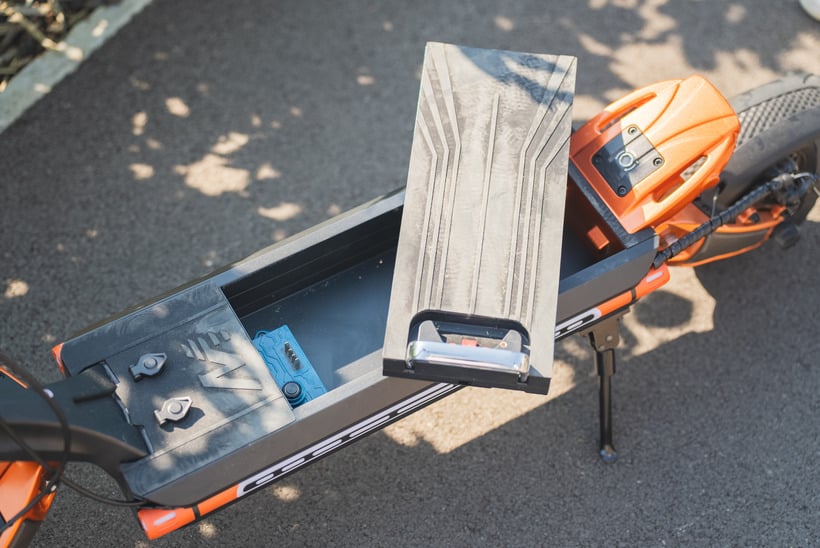
In general, the higher the voltage, amp-hours, and watt-hours, the bigger the battery’s capacity for stored energy. Here, a higher figure typically equated to a longer range.
Battery Quality
Not all electric scooter batteries are made equal. A scooter’s long-term range (i.e. over the course of years) is largely determined by the quality of its battery cells. To address this, I reported on the brand and type of cells used.
FST batteries, for example, are relatively standard units, but while they perform well in the short term, their performance degrades over time (as to be expected). Higher quality batteries made by LG, Samsung, Dynavolt, and Panasonic, on the other hand, can perform at their optimum for up to 500 charge cycles. By comparison, FST batteries typically deliver 200-300 cycles at peak performance. The difference between the two can equate to years of use depending on how often you charge your scooter. Other factors can cause a battery to degrade, too, but charge cycles are one that you have greater control over.

Battery Management Systems
Battery management systems are crucial for regulating the flow of electricity. By protecting against over-voltage, low-voltage, over-discharge, over-current, and over-temperature, they keep batteries operating within safe parameters.
They also report key information back to the scooter's display, allowing you to view things like battery level, temperature readouts, and error codes that correspond to certain issues.

With the above in mind, I made sure to only select the scooters that had battery management systems.
Charge Time
Long-range rides can deplete your battery, so a fast recharge time (within reason) is preferred.
To assess how long this takes, I considered the manufacturer’s specs, alongside my calculations where I divided each battery’s amp hours (Ah) by the amperage (A) of the included charger.
Expert Tip: If you opt for a scooter that has a battery bigger than 15Ah then you may want to purchase a fast charger to significantly reduce the charge time.
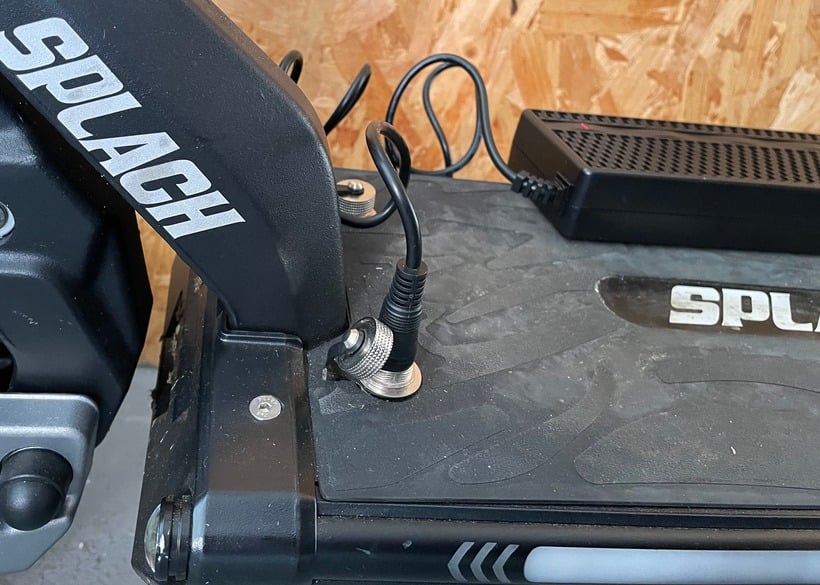
Electric Scooter Chargers: How to Charge, Expert Tips & Fast Chargers
Ride Quality
Ride quality is fundamental to the appeal of a long-range electric scooter.
Aside from testing each scooter hands-on to garner insights into their comfortability and handling, I also conducted several assessments to determine how the geometry and shock-absorbing profile of each influenced their riding experience.
To do this, I first measured their handlebar width, usable deck space, and deck-to-handlebar height. The wider the handlebars, the greater the control. The bigger the usable deck space, the larger the room to find a natural riding stance. And, the higher the deck-to-handlebar height, the better your posture (this also allowed me to identify the suitability of each scooter for riders of different heights).

Then, to assess each scooter’s ability to soak up shocks, I tested their rebound and compression rates, the balance of shock absorption across the front and rear of the scooter, the amount of travel that the swingarms and suspension provided, and whether there was any bottoming out. All of this coalesced into a shock absorption rating out of 10 – where 1 was extremely stiff and 10 was extremely soft.
Tires are just as important as shock absorption – especially for scooters that don’t have a suspension system. To assess performance in this area, I paid particular attention to agility and traction.

The final assessments were made on how well each scooter responded to different inputs (i.e. is the throttle smooth or jerky, can you carve from side to side, is there a cruise control feature and if so how effective is it at maintaining speed, etc).
Reliability
Imagine it: you’re on mile 25, in the middle of nowhere, when you hear a pop. Flat tire. Disaster! Reliability is crucial for long rides, so the tests that I conducted took into account durability.
Here, I reported on the quality of the tires (i.e. their ability to prevent punctures), the rigidity of each scooter (i.e. checking for vulnerabilities that could cause structural issues such as stem wobble), and the protection against wet weather (i.e. IP ratings). All of these factors were considered relative to price.









